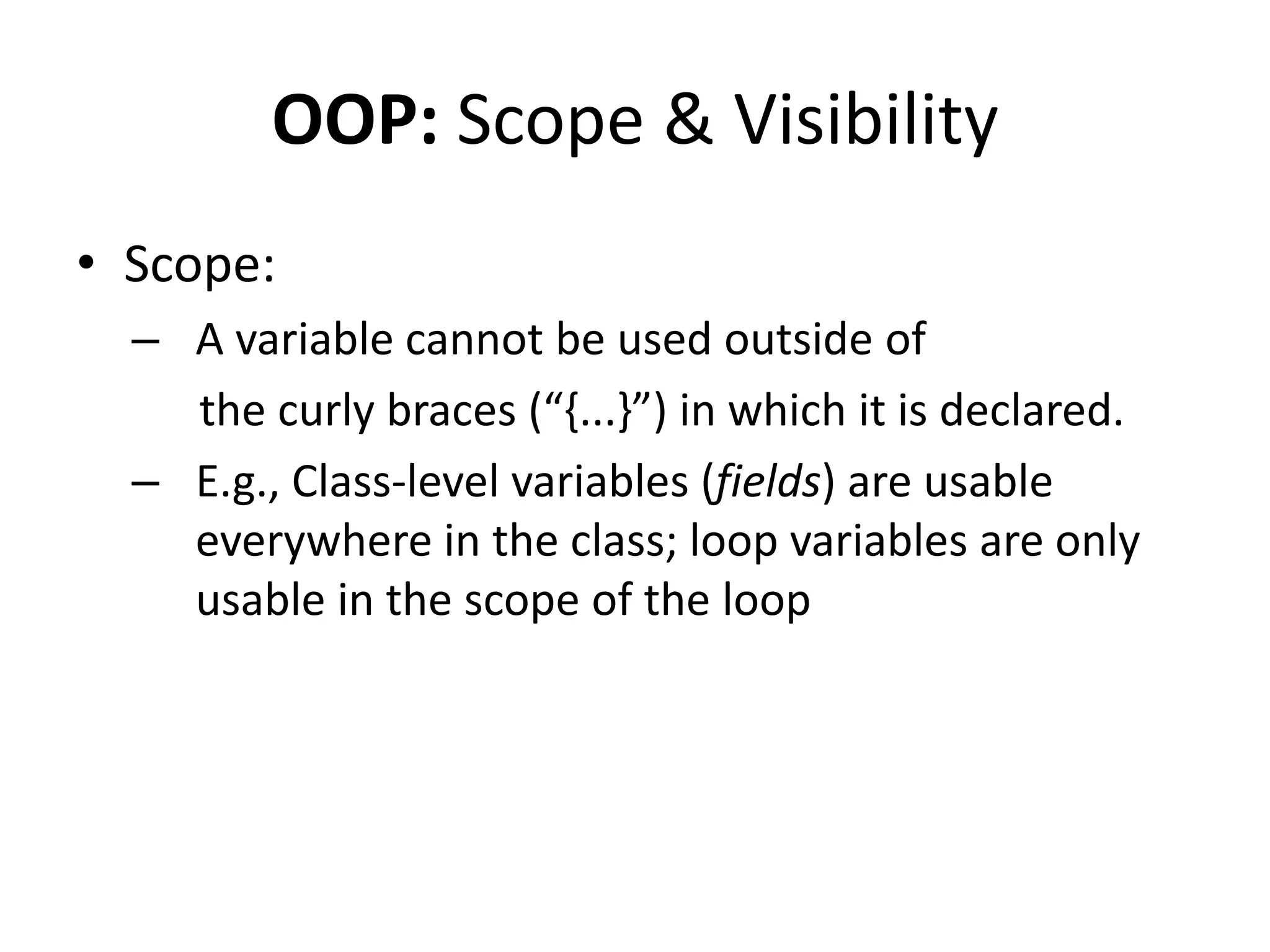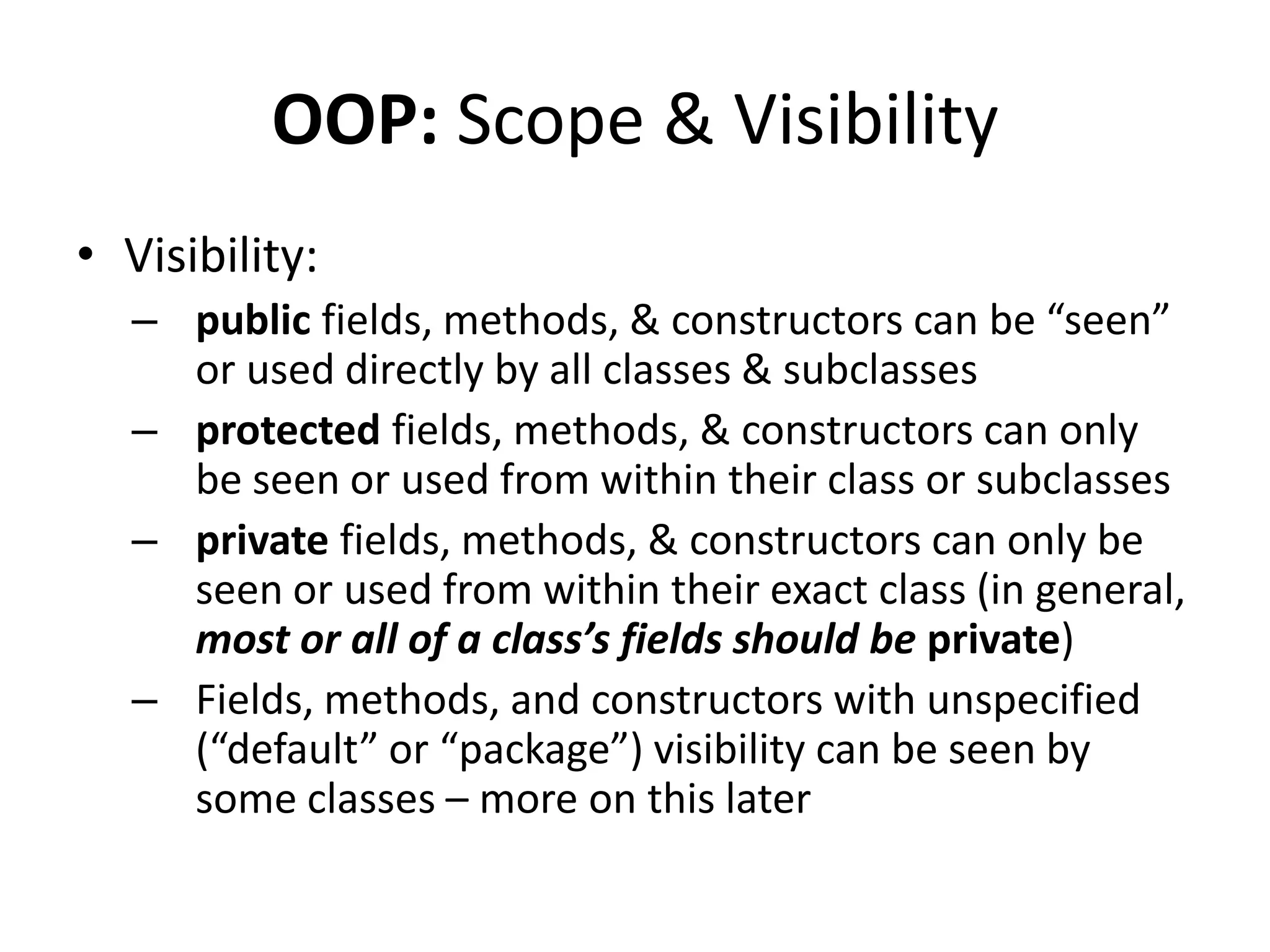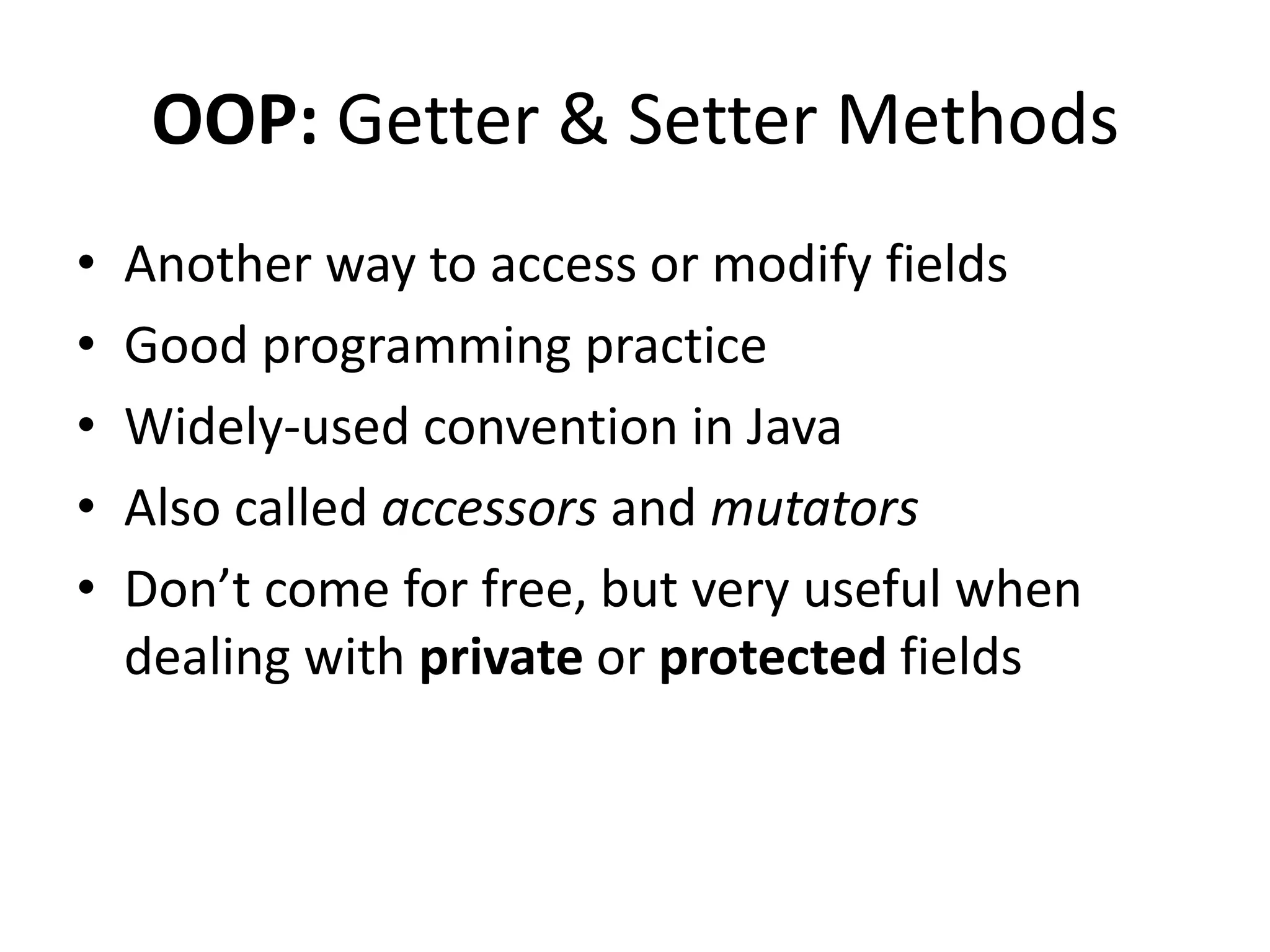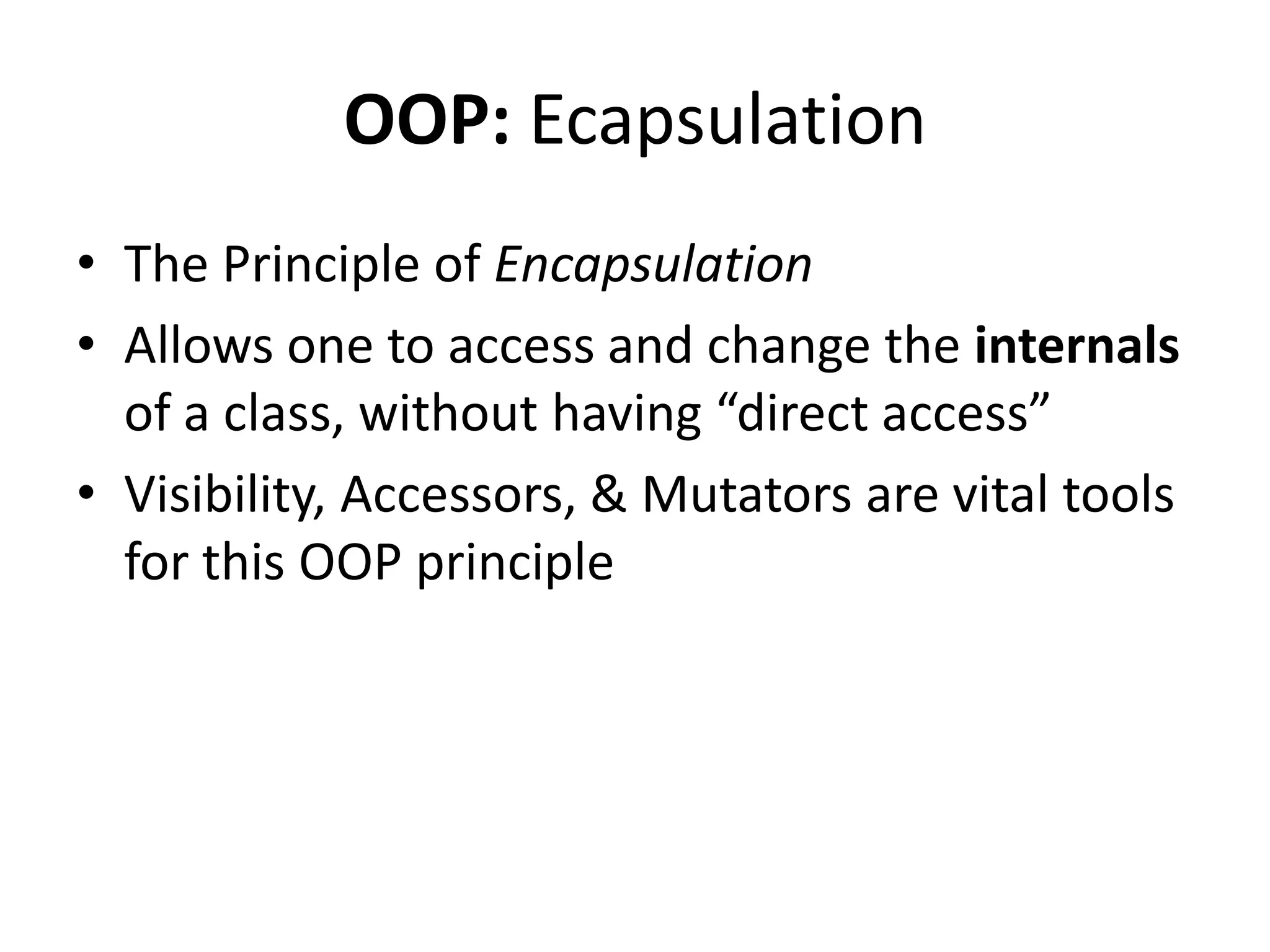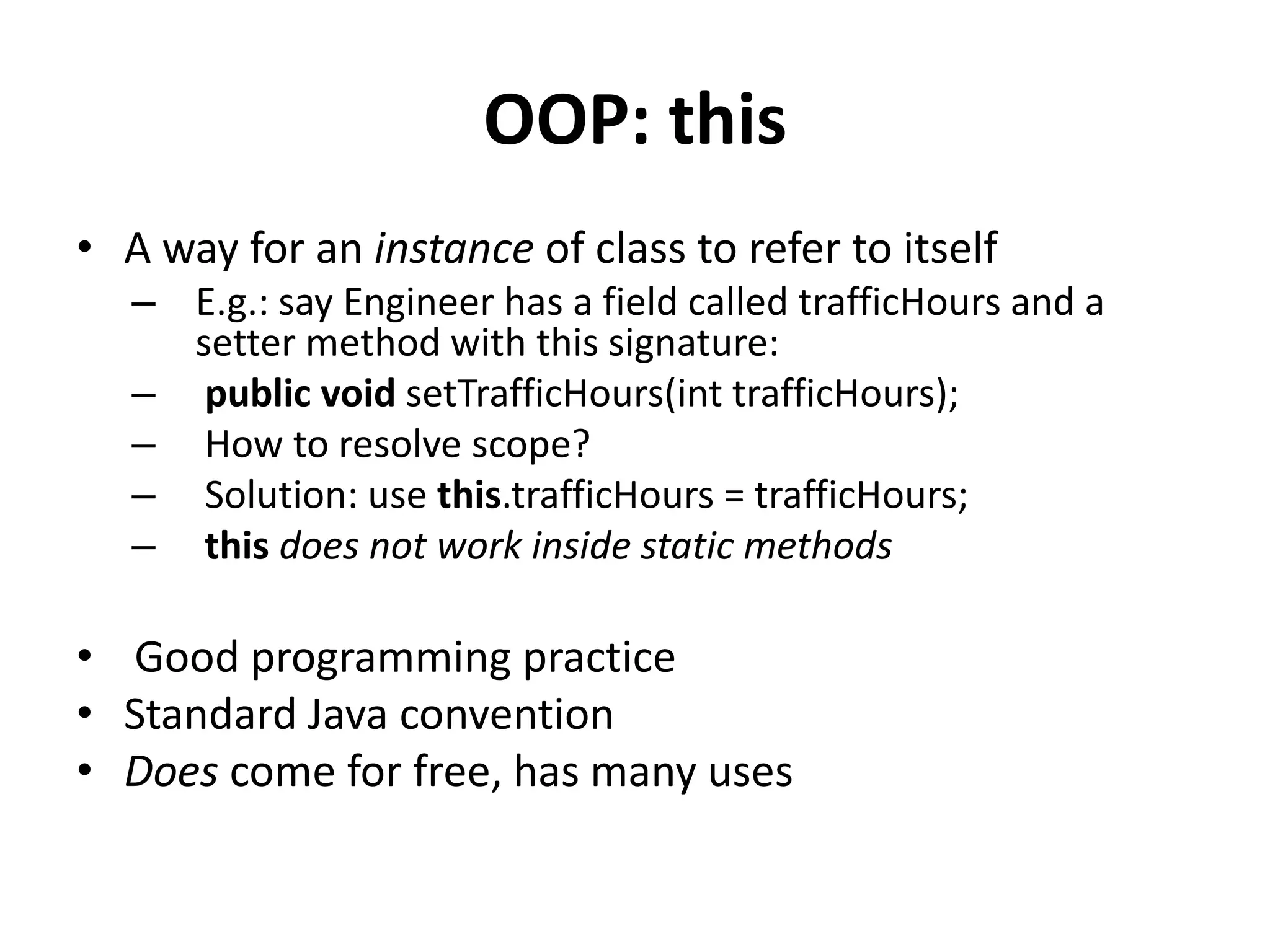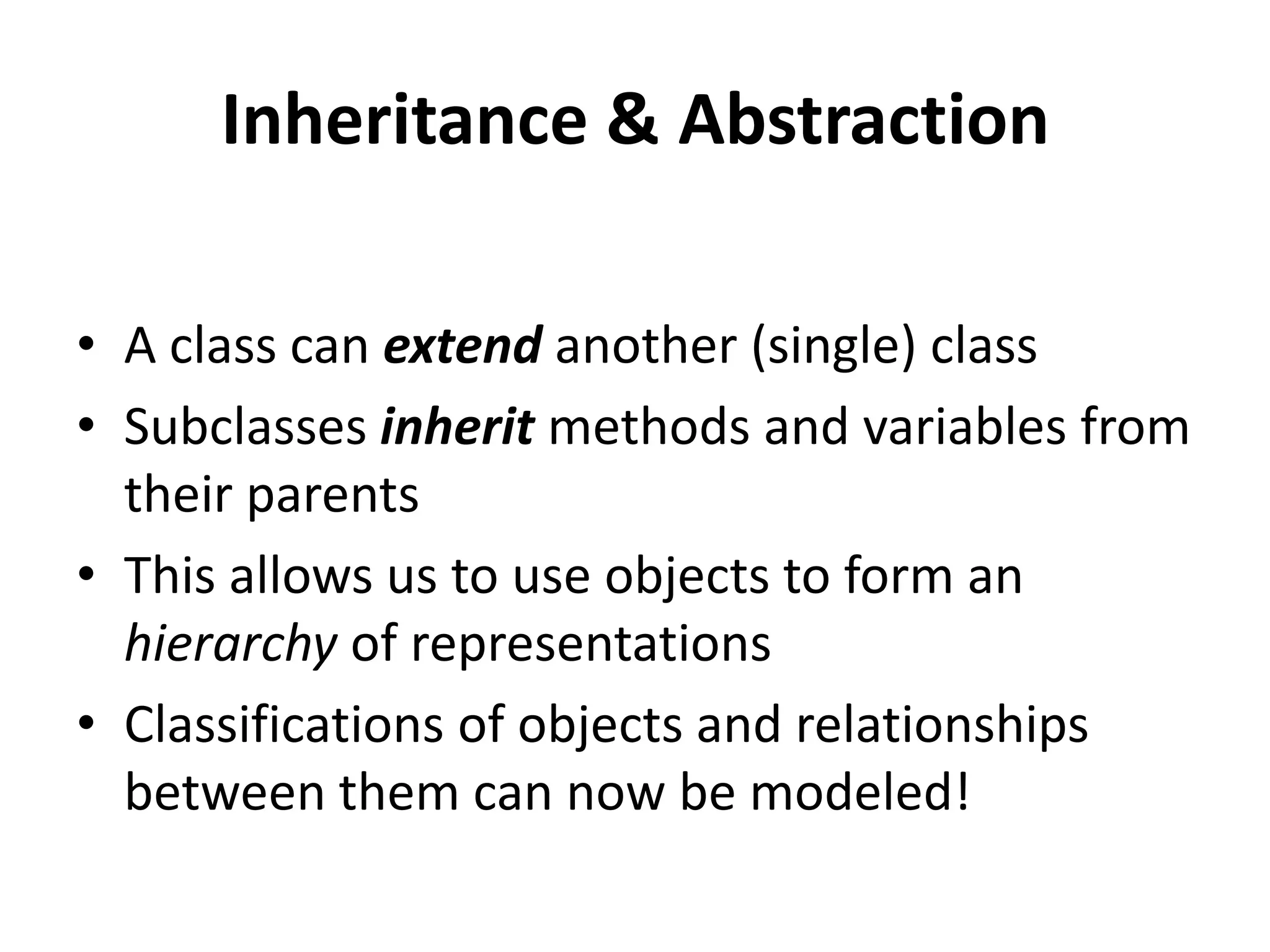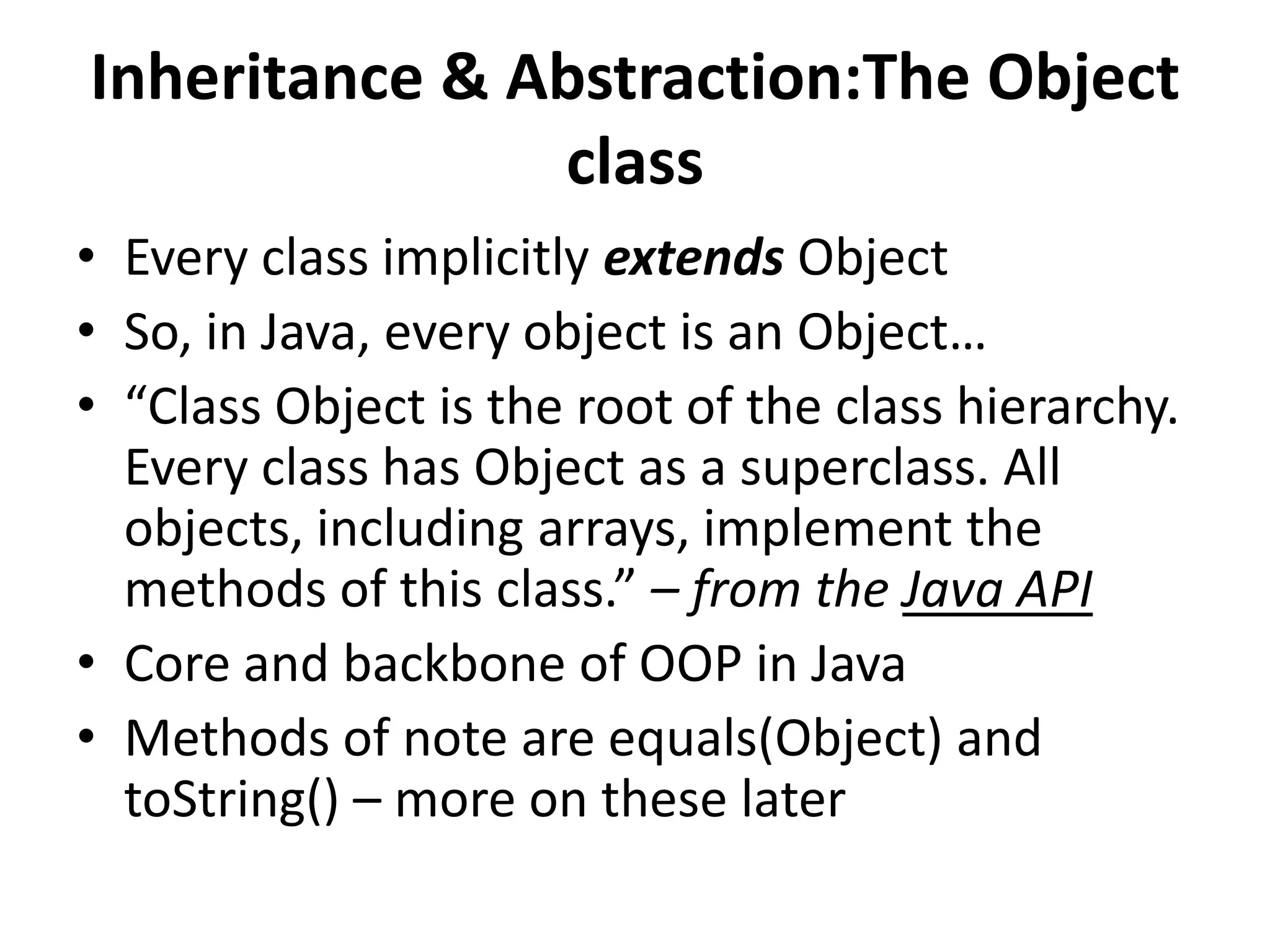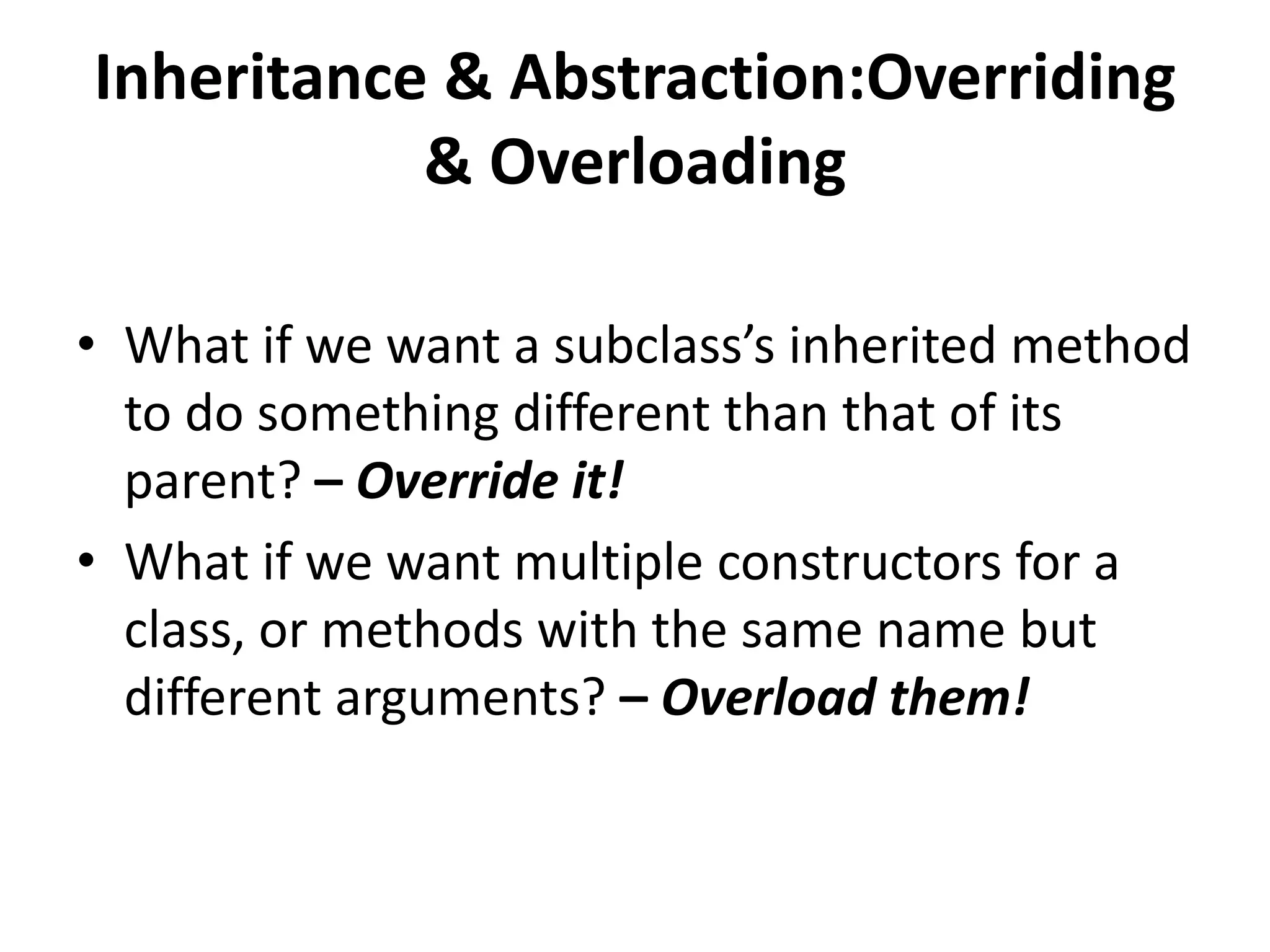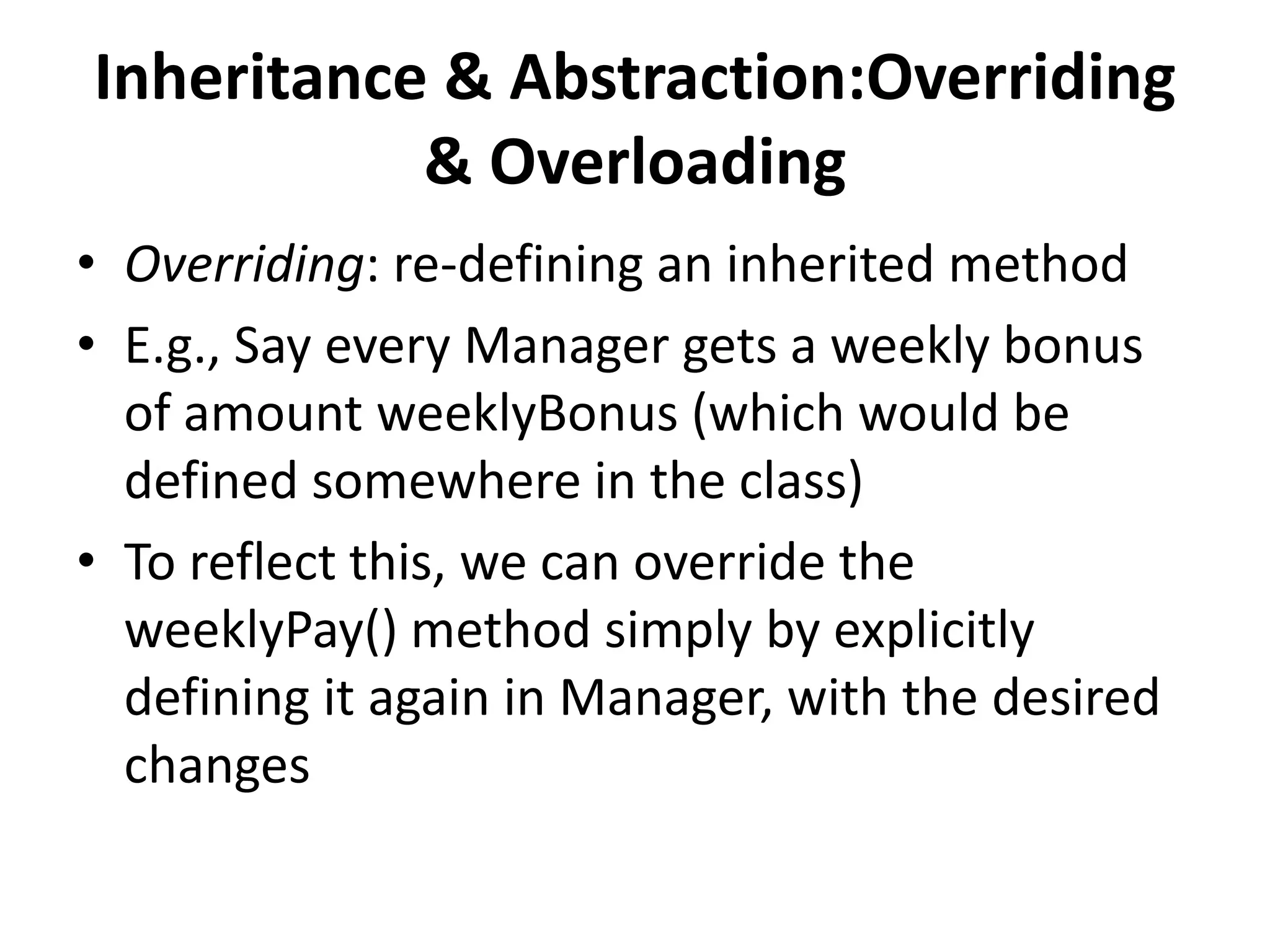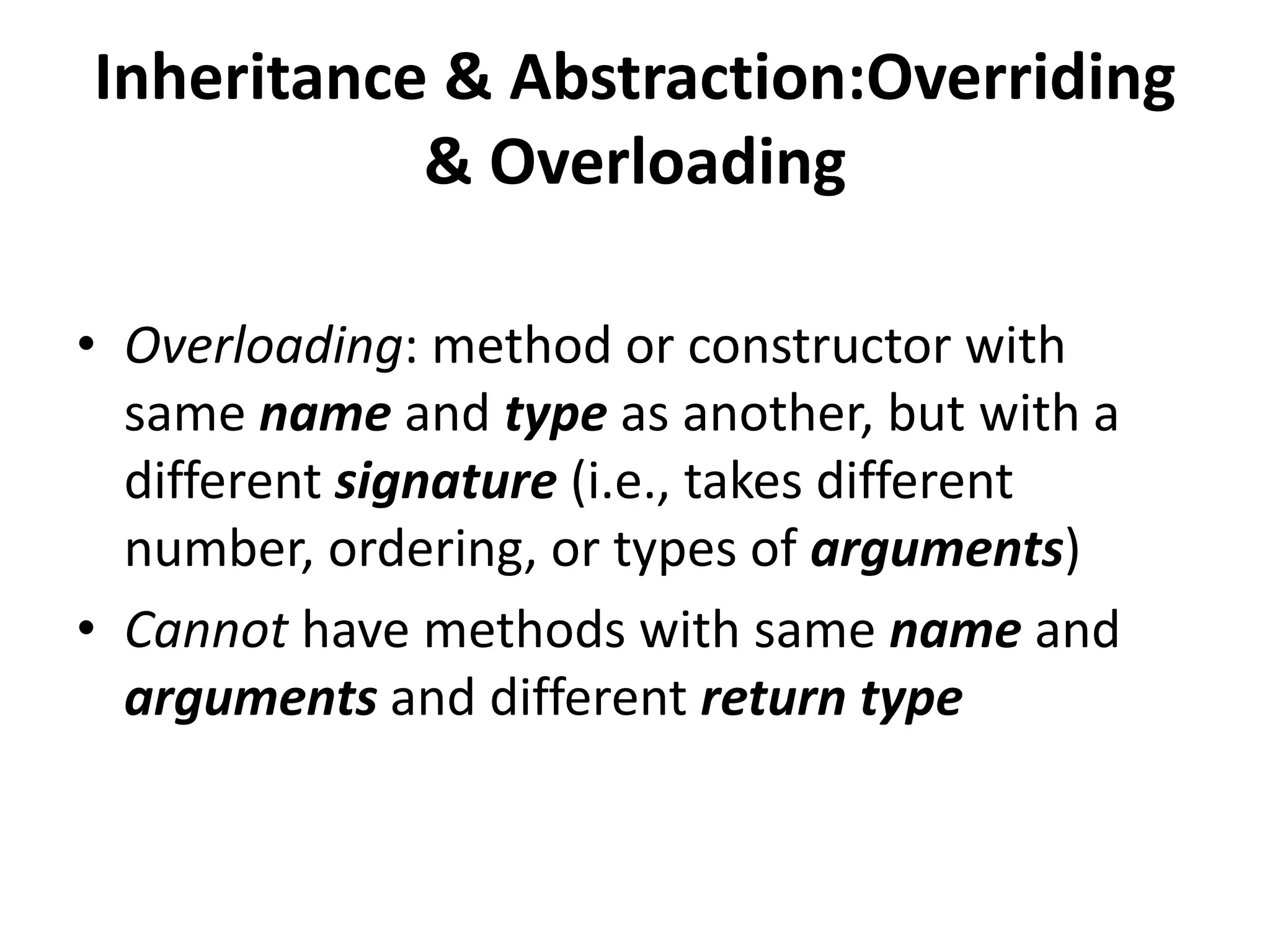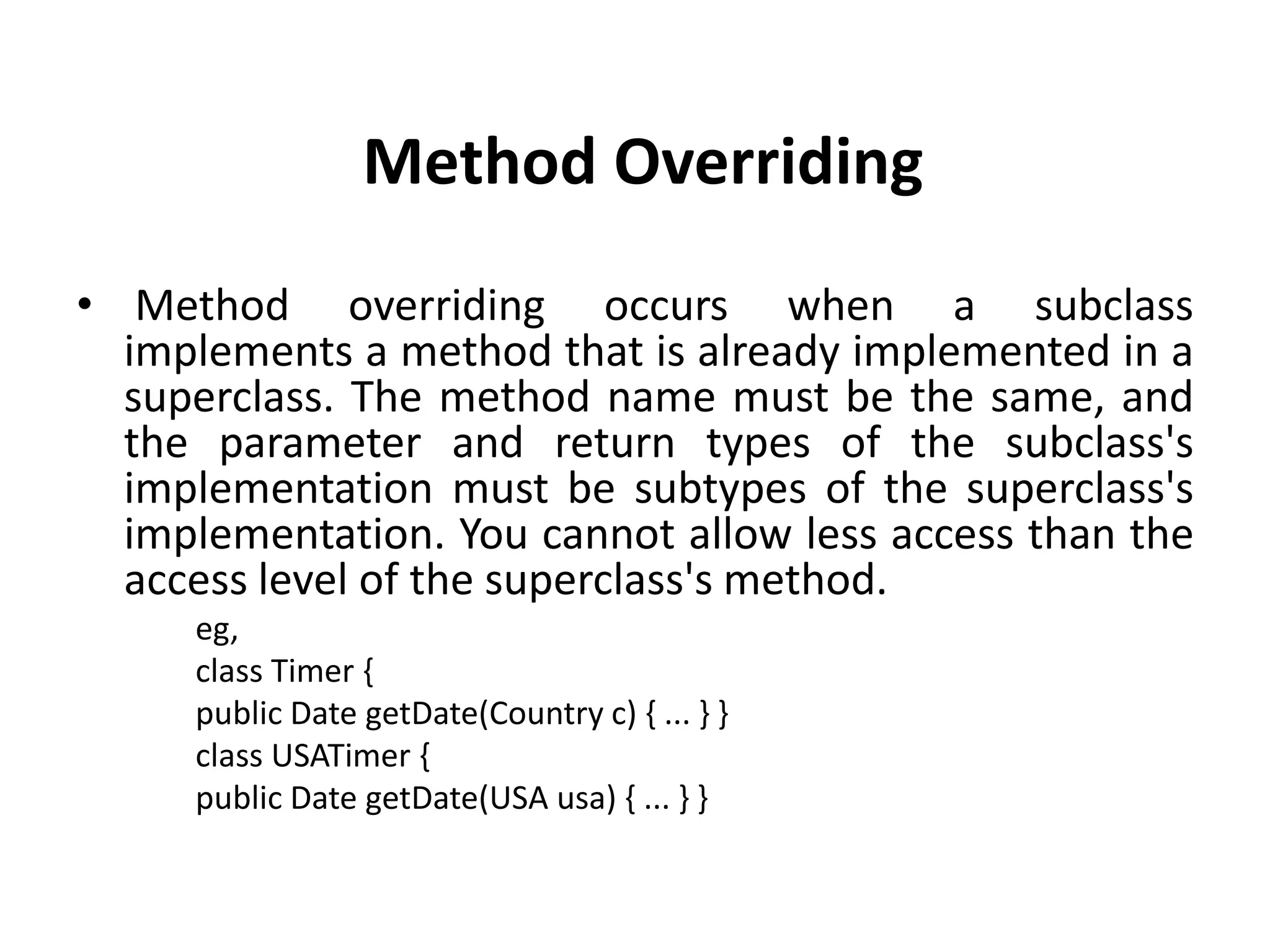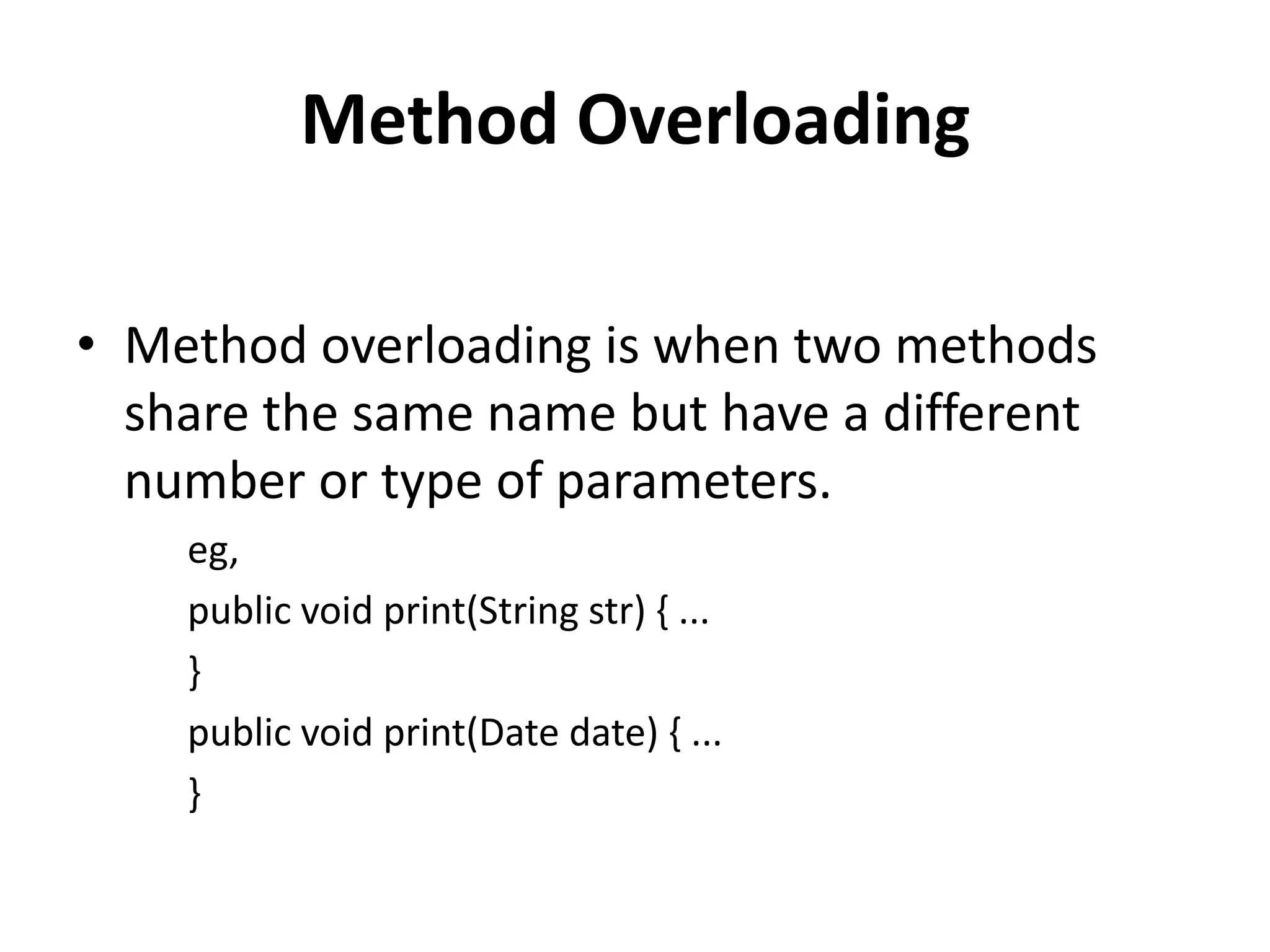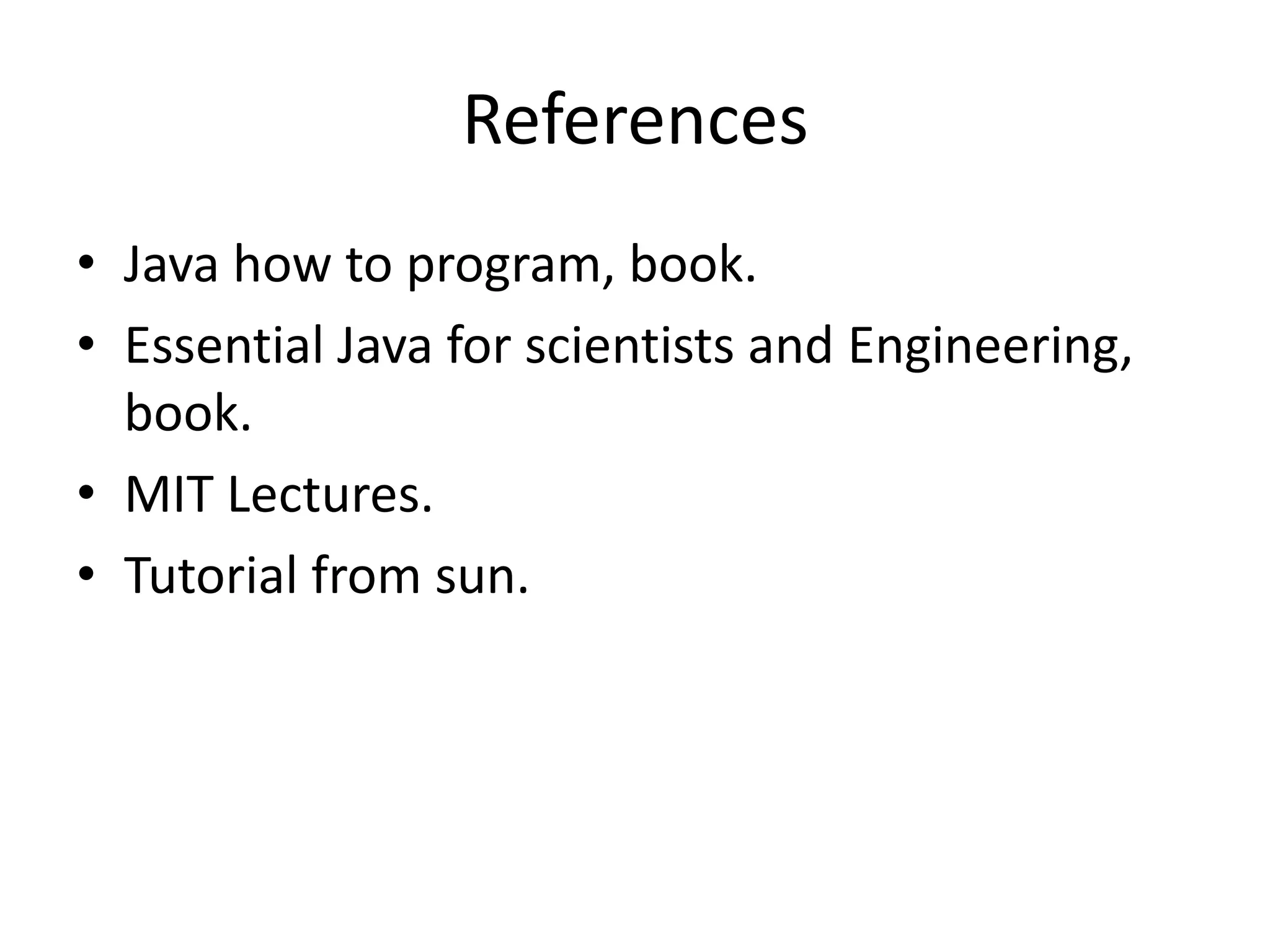This document provides an overview and agenda for a Java introduction presentation. It covers topics like the types of programming languages, what Java is and why it was developed, how to set up your environment to write Java programs, the basics of the Java language including variables, types, operators, methods, conditionals, loops, arrays, and object-oriented programming concepts. It also discusses how to write a first simple Java program and solve problems using Java.
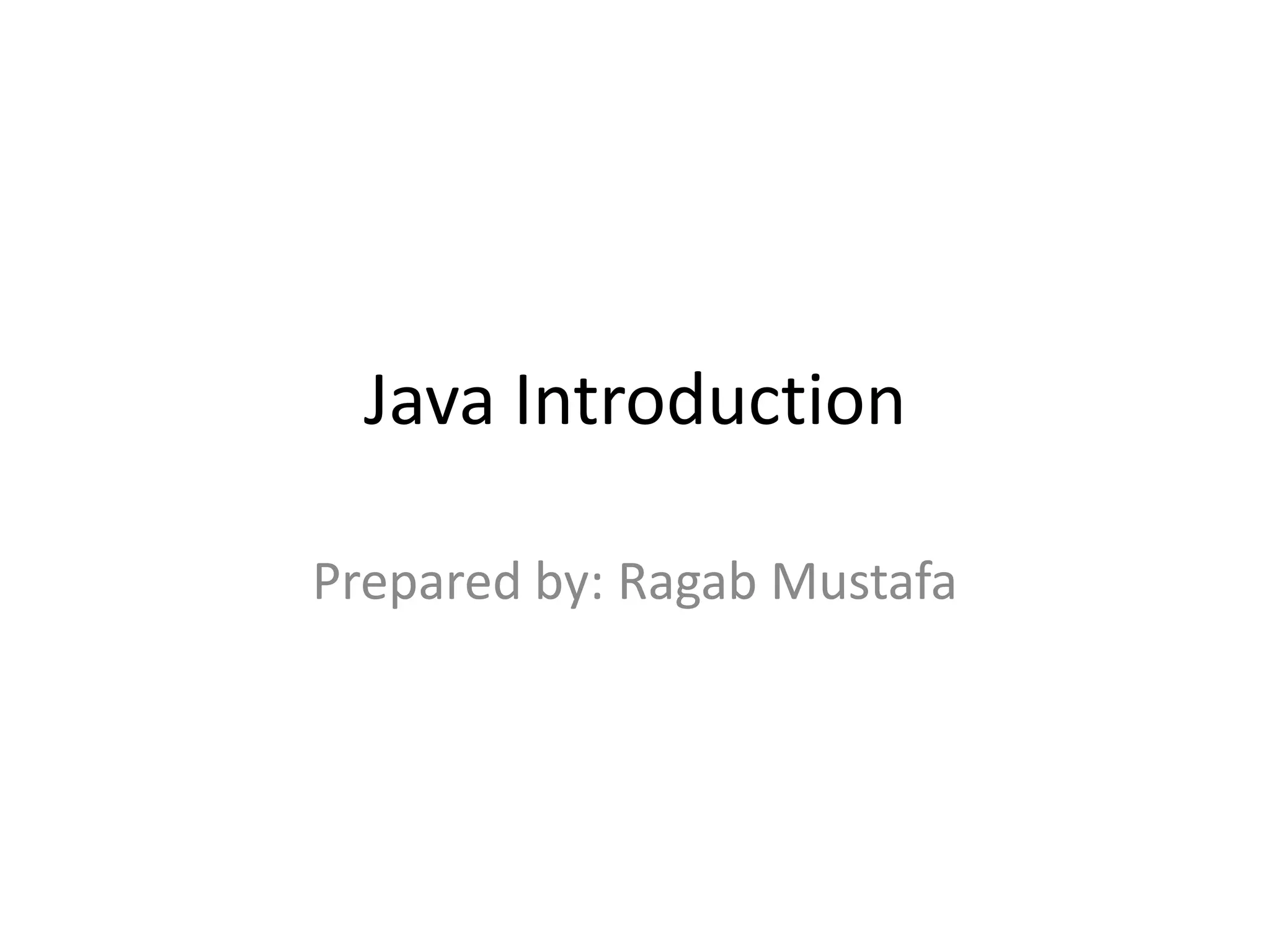
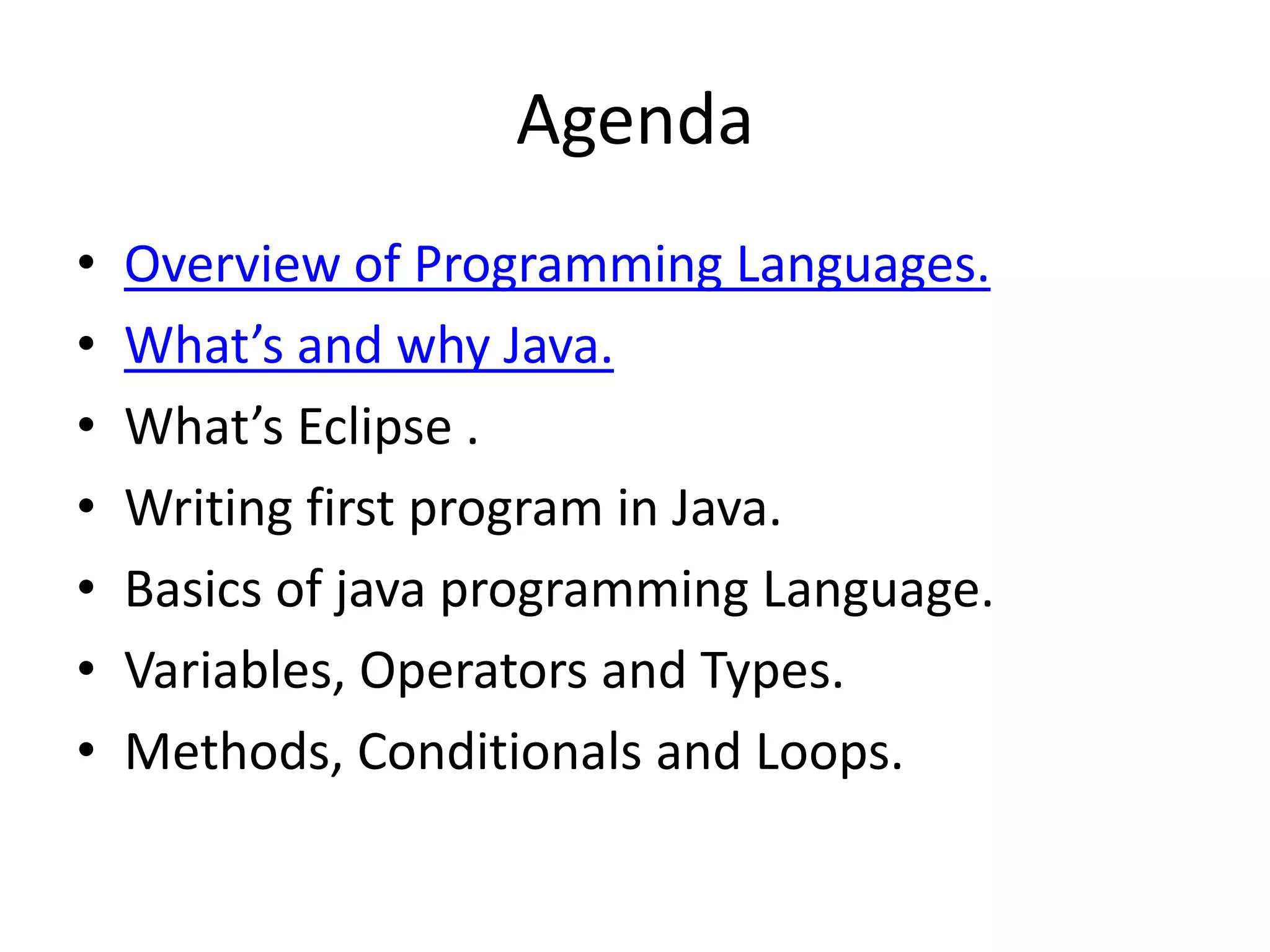
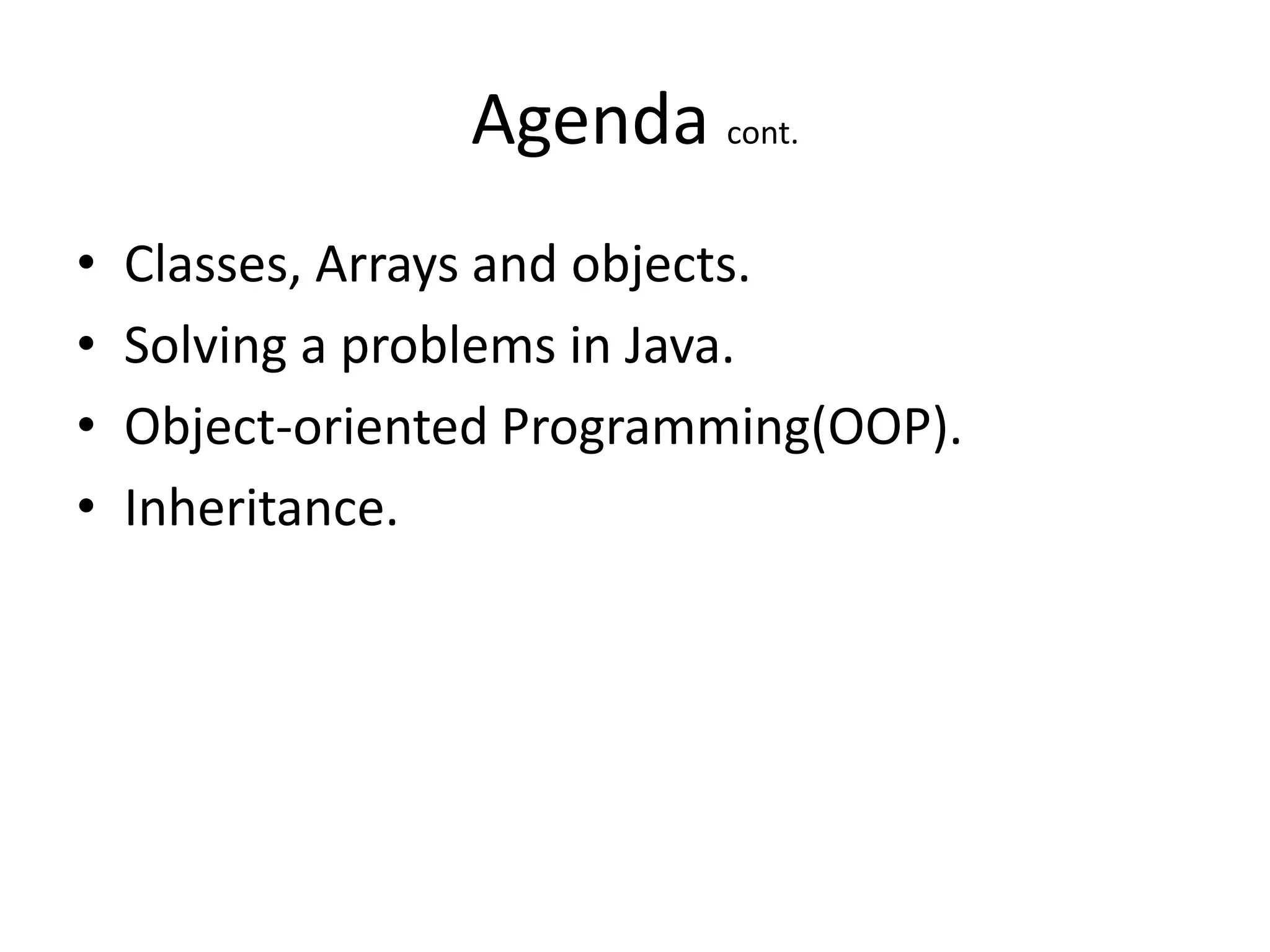
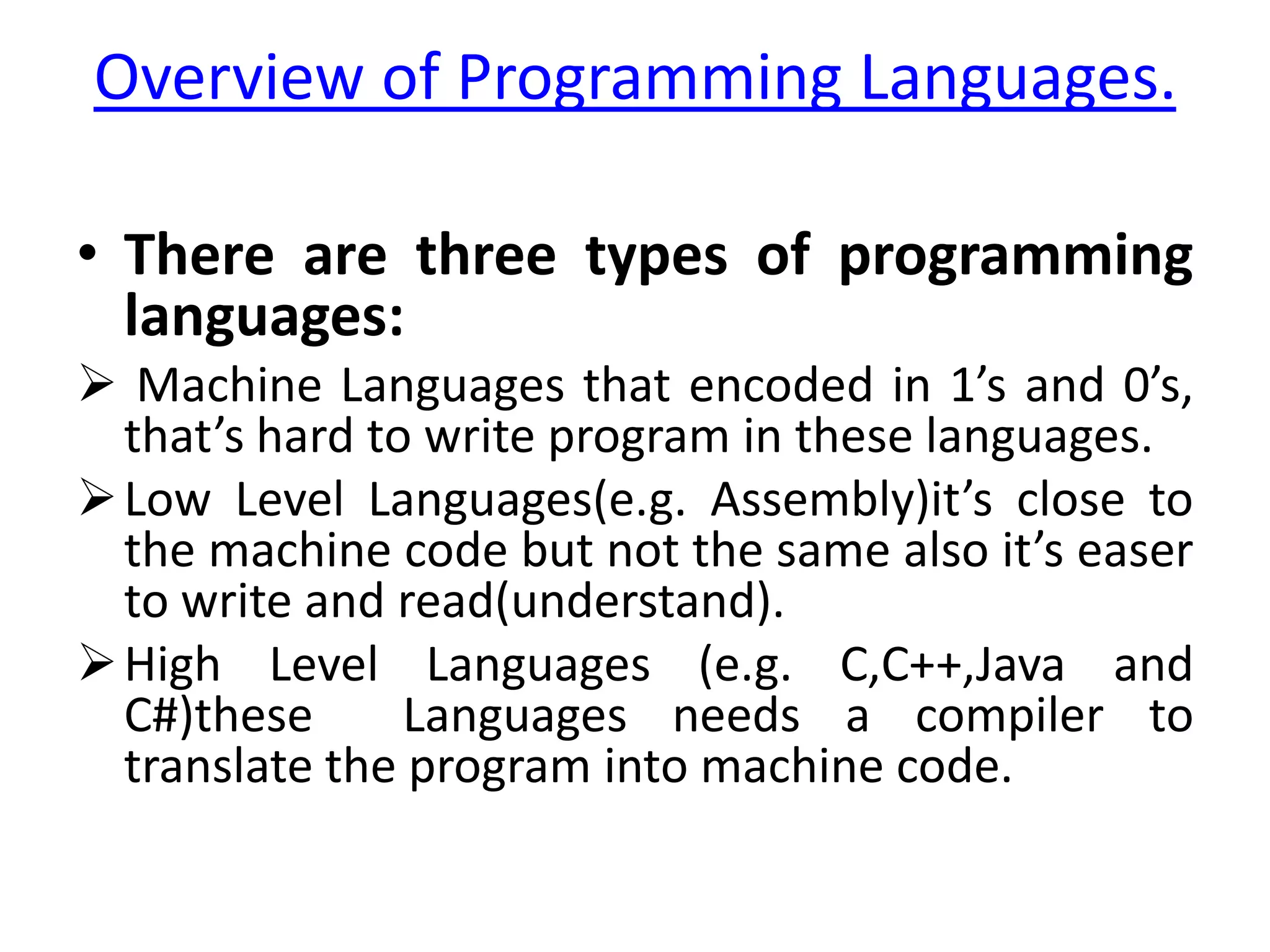
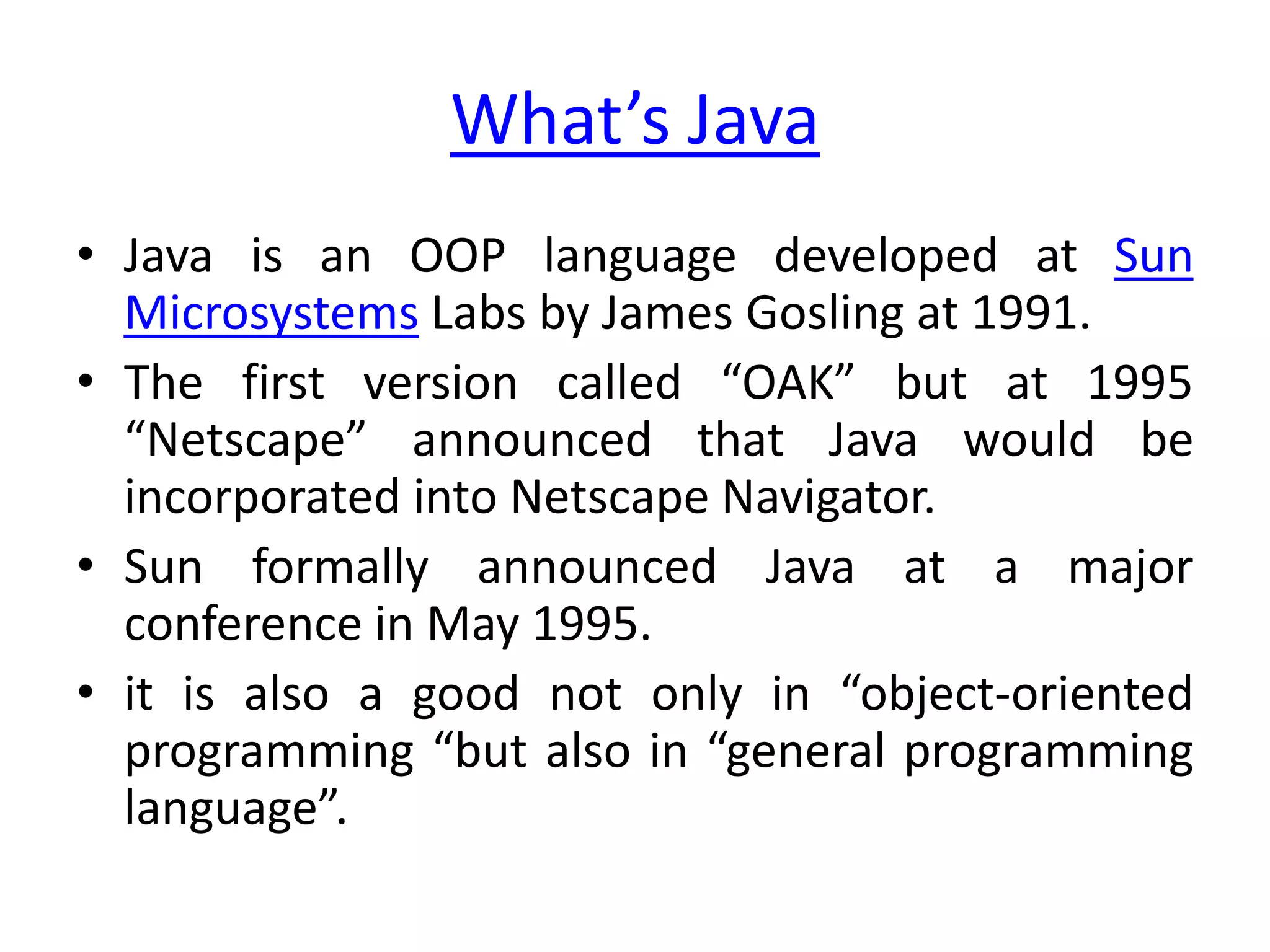
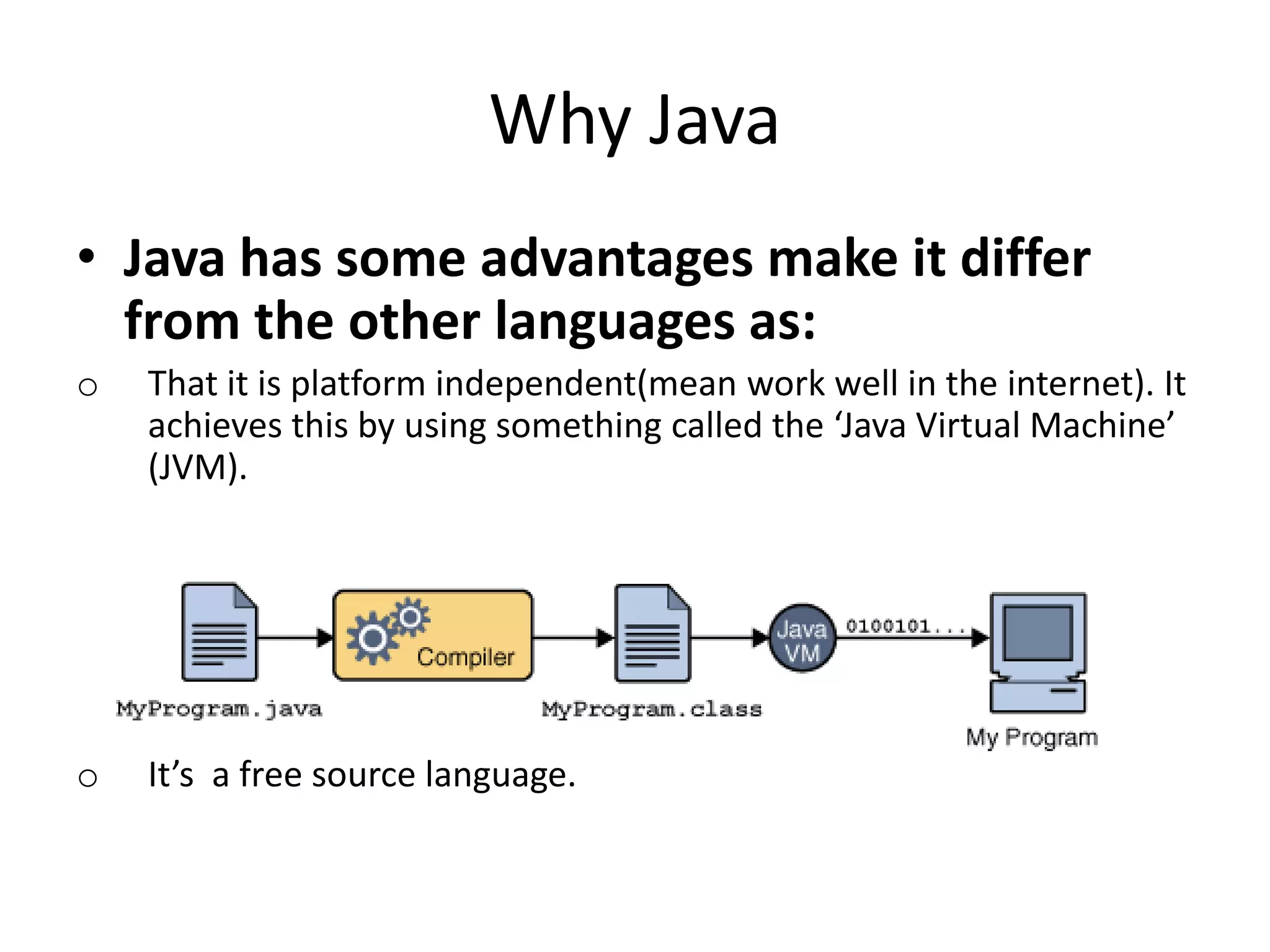
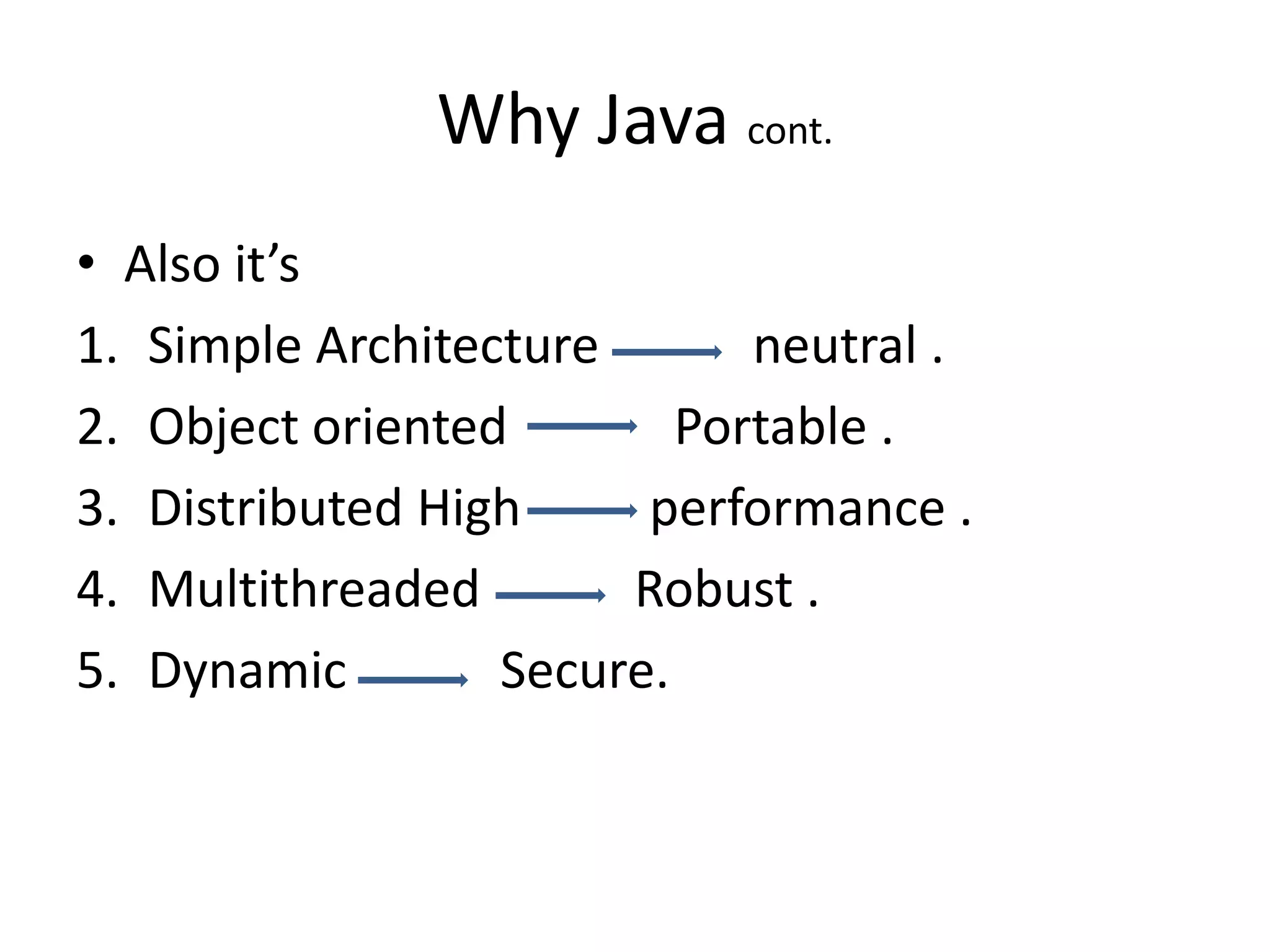
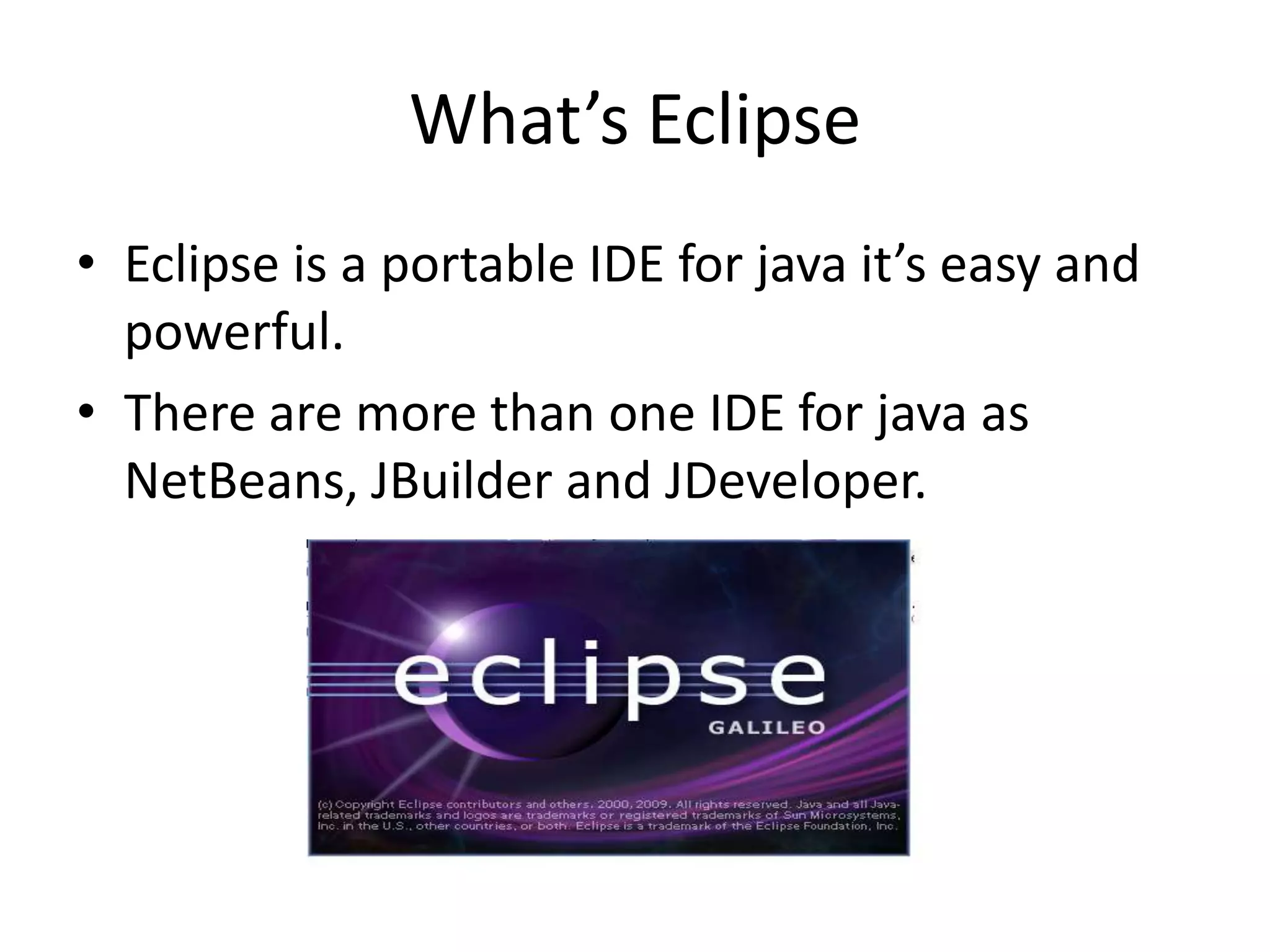
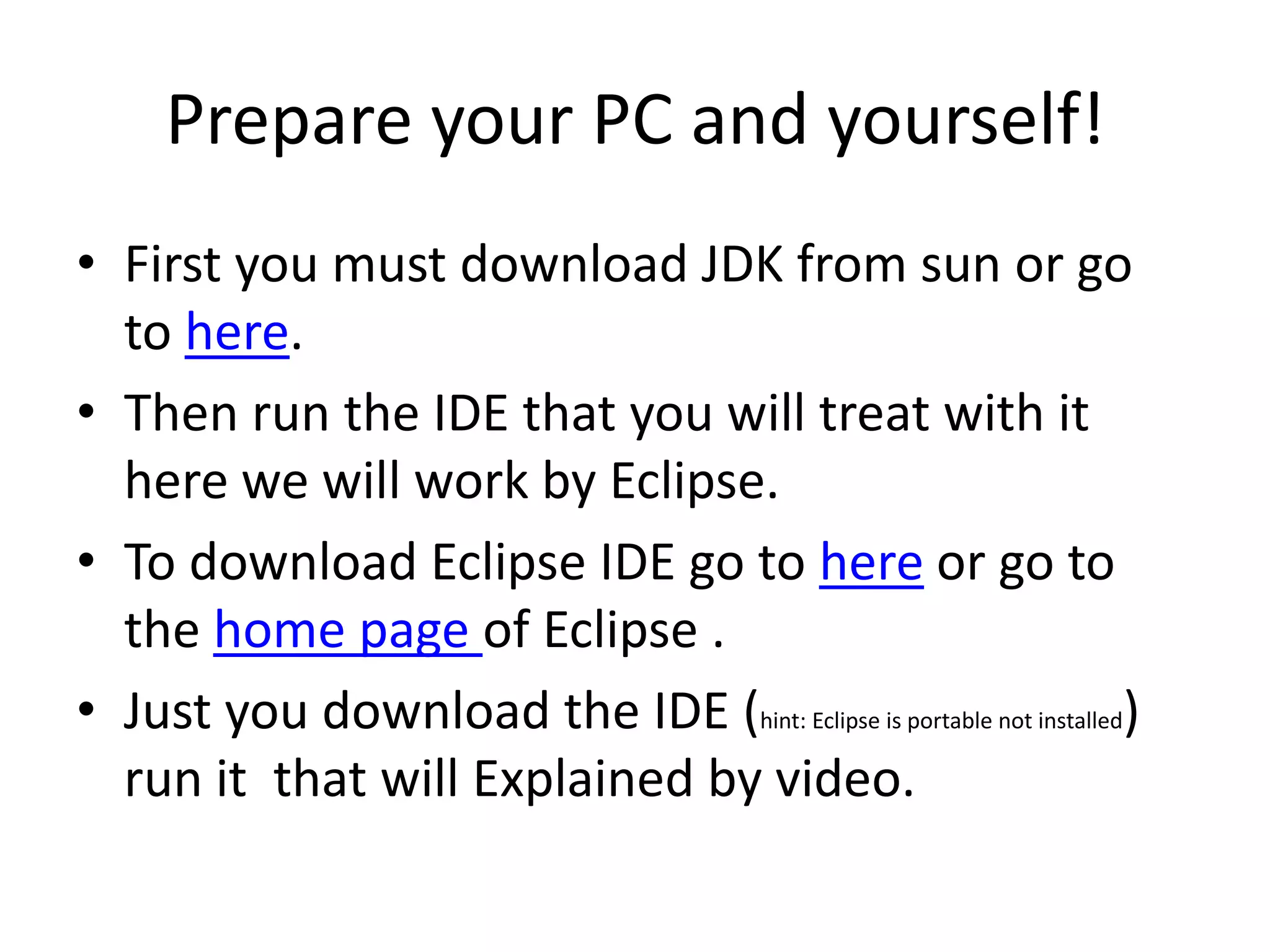
![The first program in java
• Write the program:
public class FirstProgram
{
public static void main (String[] args)
{
System.out.print("Hello, 2 + 3 = ");
System.out.println(5);
System.out.println("Good Bye");
}
}](https://image.slidesharecdn.com/javaintroduction-110515011820-phpapp01/75/Java-introduction-10-2048.jpg)
![Basics of Java
• Program Structure
class CLASSNAME {
public static void main(String[] args)
{
STATEMENTS
}
}](https://image.slidesharecdn.com/javaintroduction-110515011820-phpapp01/75/Java-introduction-11-2048.jpg)
![Variables
• Named location that stores a value
• Form:
TYPE NAME;
• Example:
String fName;
class Hello {
public static void main(String[] arguments)
{
String fName = “ragab”;
System.out.println(fName);
fName = "Something else";
System.out.println(fName);
}
}](https://image.slidesharecdn.com/javaintroduction-110515011820-phpapp01/75/Java-introduction-12-2048.jpg)
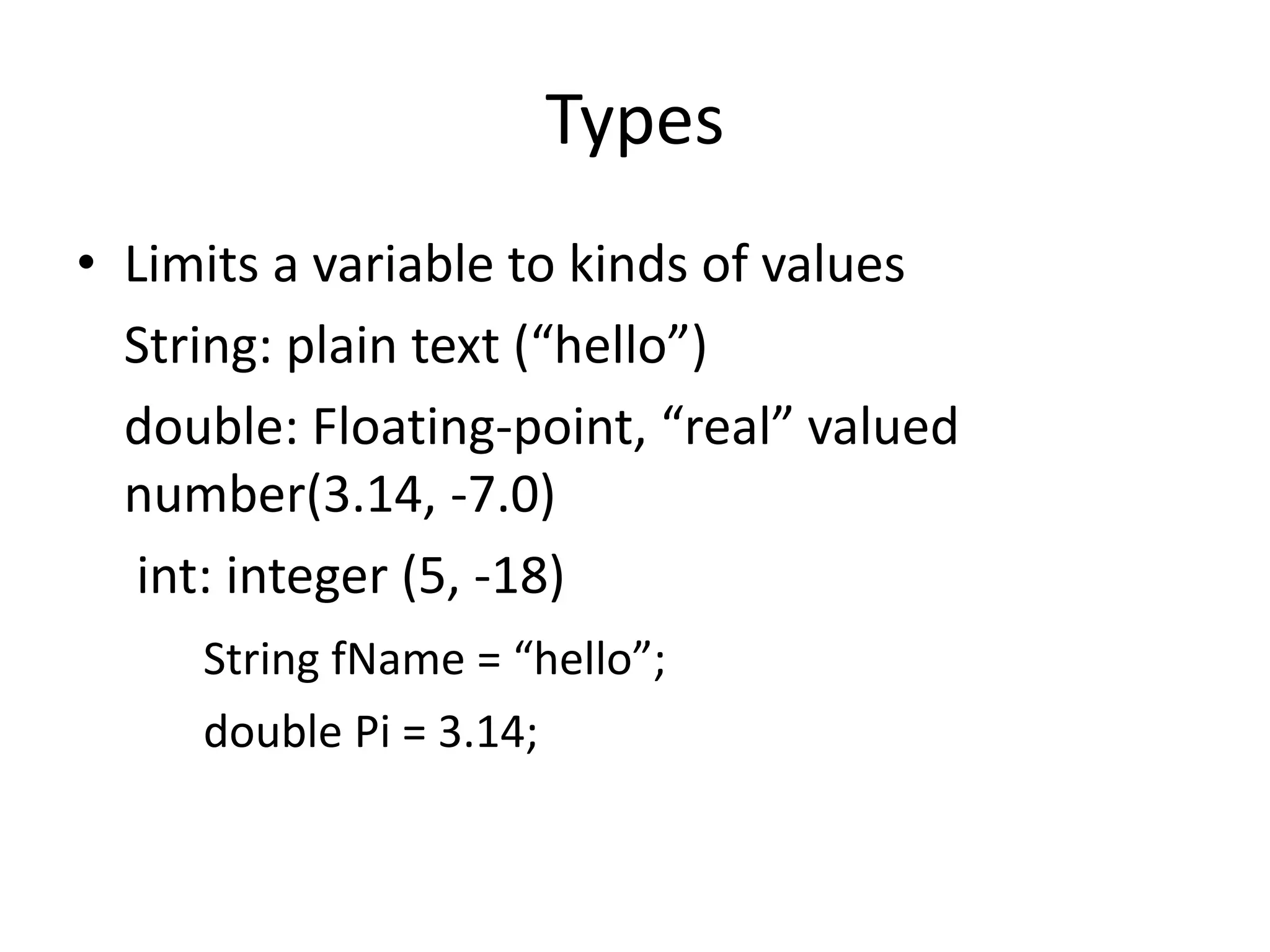
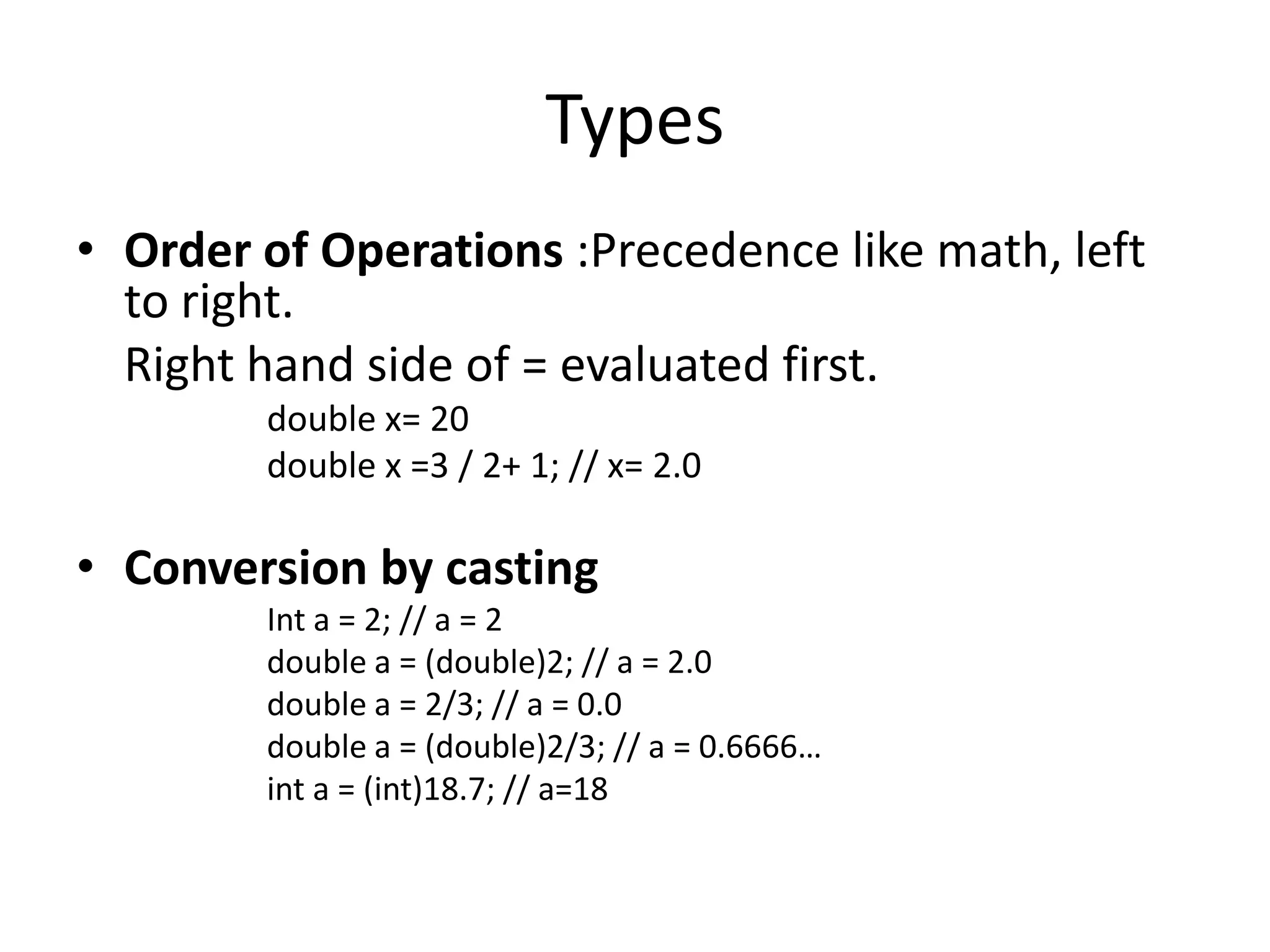
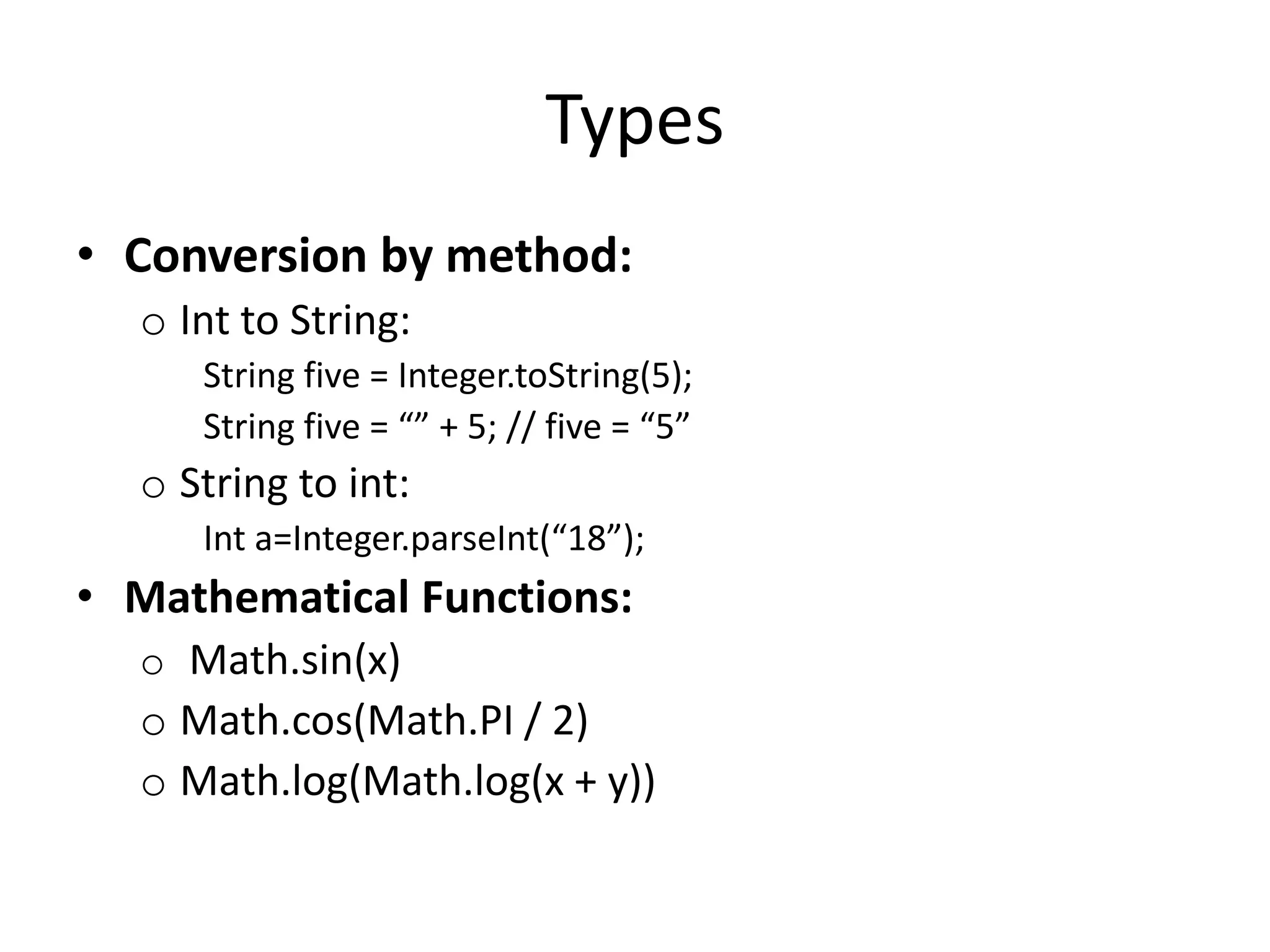
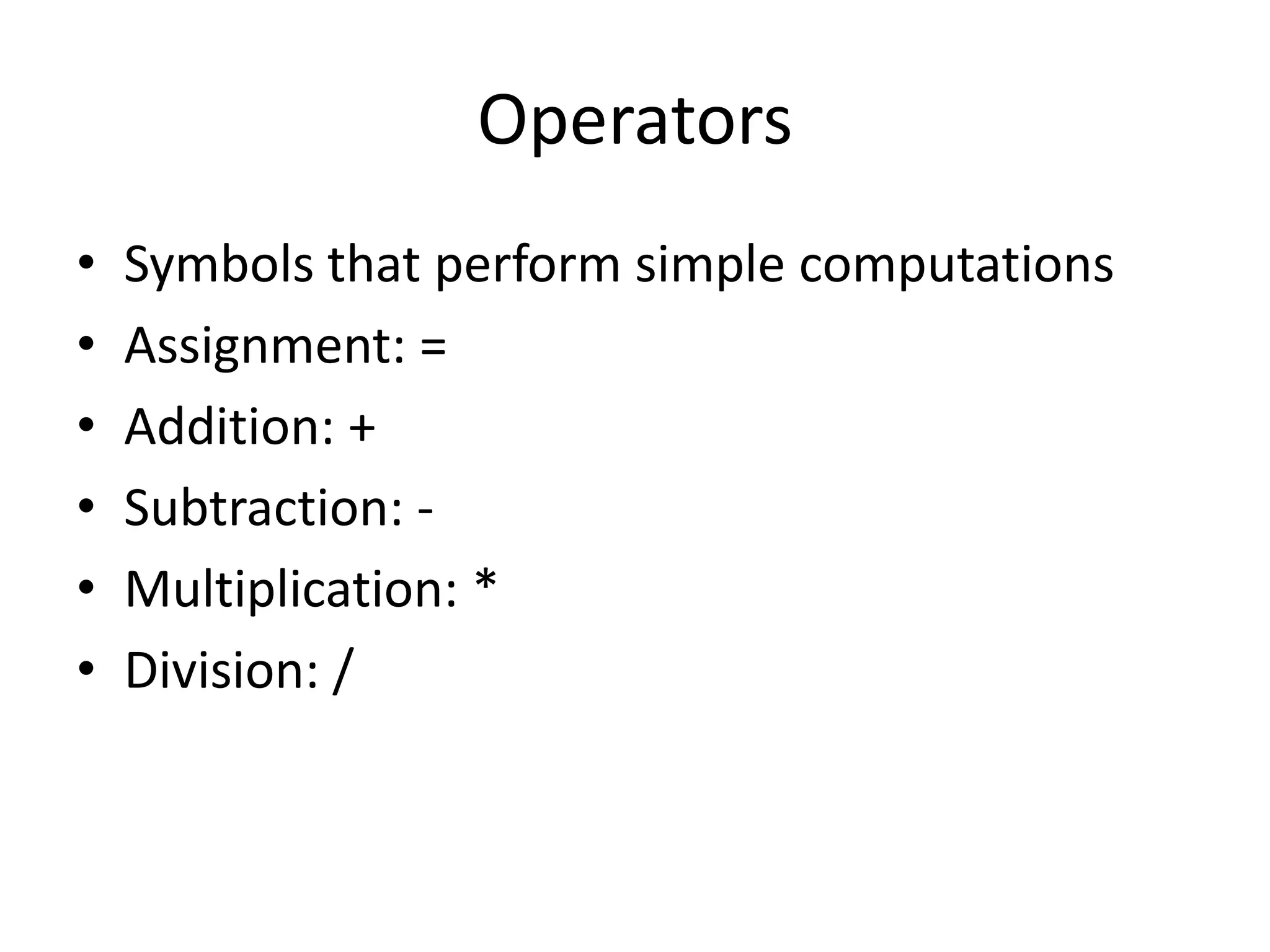
![Example
class Math {
public static void main(String[] arguments)
{
int score;
score = 1 + 2 * 3;
System.out.println(score);
double copy = score;
copy = copy / 2;
System.out.println(copy);
score = (int) copy;
System.out.println(score);
}
}](https://image.slidesharecdn.com/javaintroduction-110515011820-phpapp01/75/Java-introduction-17-2048.jpg)
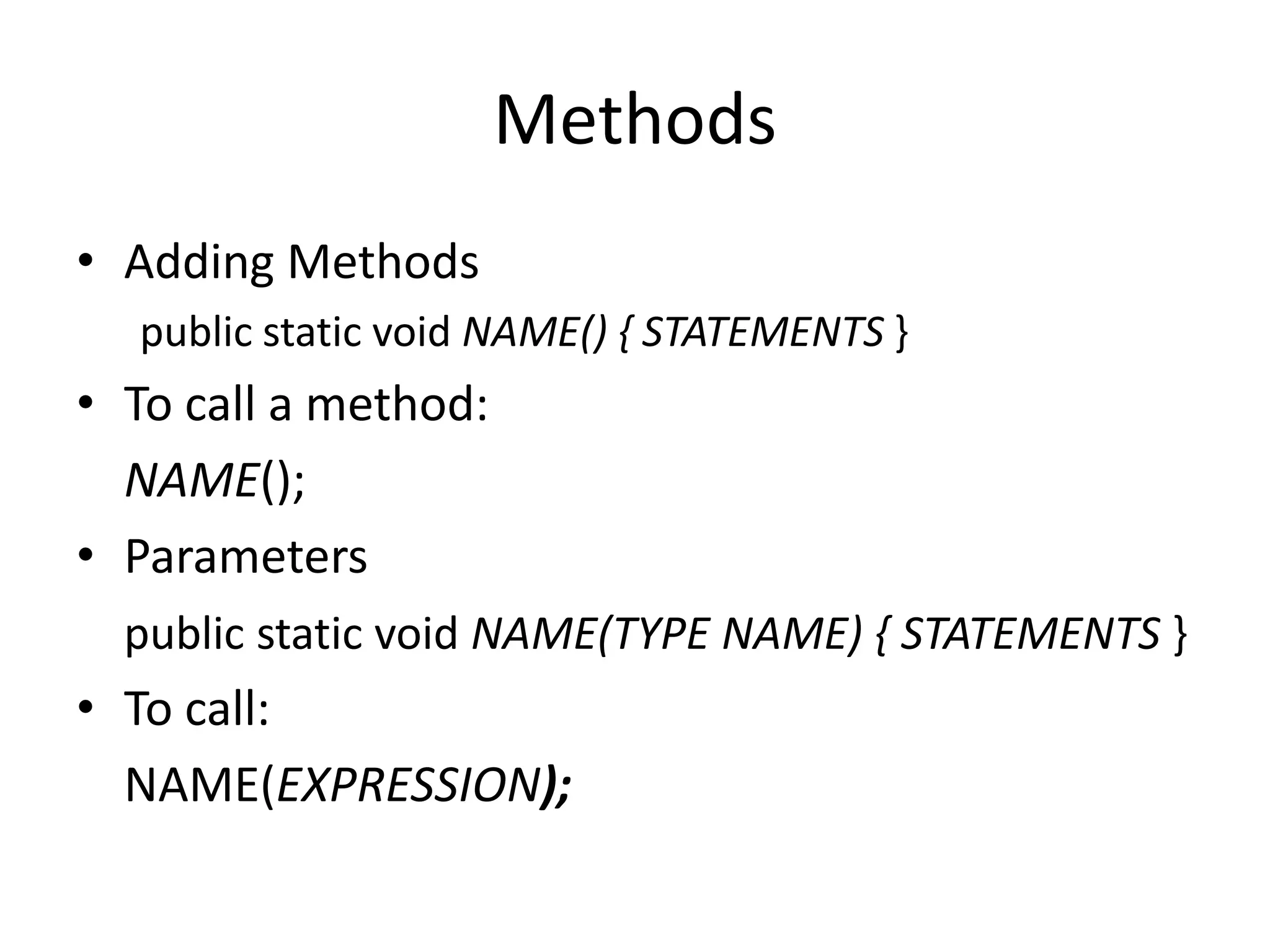
![Methods
• Example:
class Square {
Public static void printSquare(int x){
System.out.println(x*x);}
public static void main(String[] arguments){
int value = 2;
printSquare(value);
printSquare(3);
printSquare(value*22);
}
}](https://image.slidesharecdn.com/javaintroduction-110515011820-phpapp01/75/Java-introduction-19-2048.jpg)
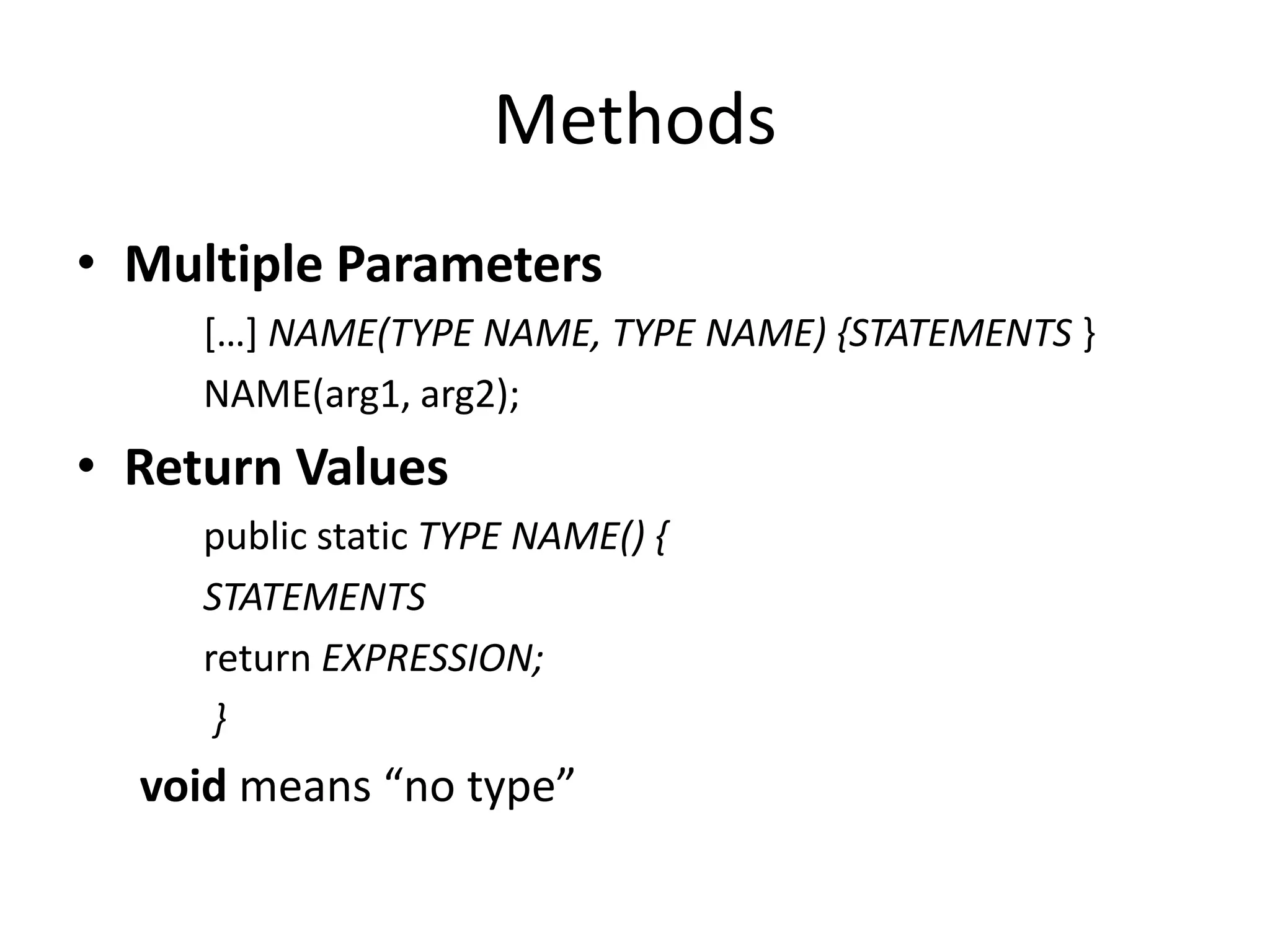
![Conditionals
• if statement
if (COMPARISON) {STATEMENTS }
• Example:
class If {
public static void test((int x)) {
if (x > 5){
System.out.println((x + " is > 5");
}
}
public static void main(String[] arguments){
test(6);
test(5);
test(4);
}
}](https://image.slidesharecdn.com/javaintroduction-110515011820-phpapp01/75/Java-introduction-21-2048.jpg)
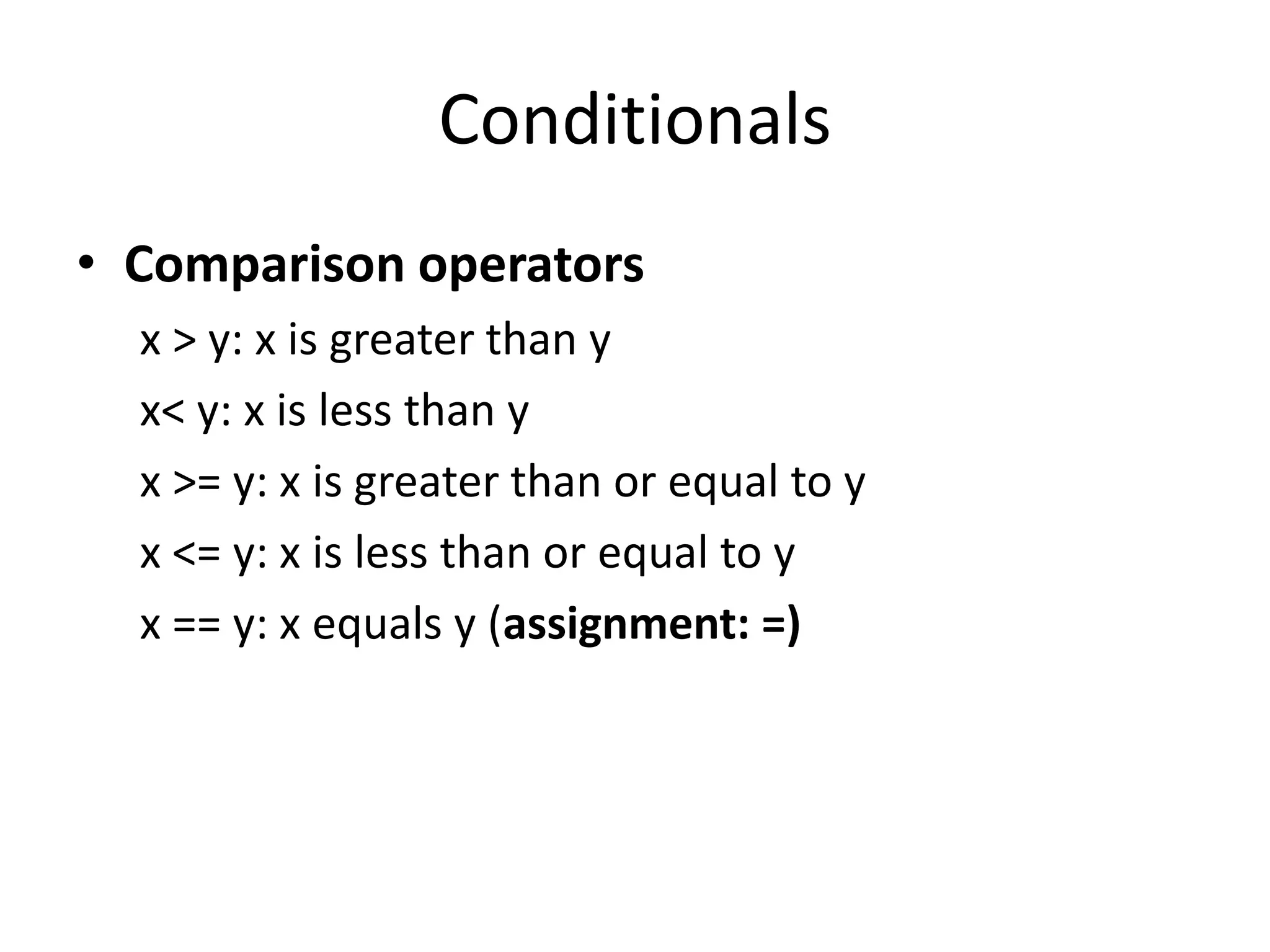
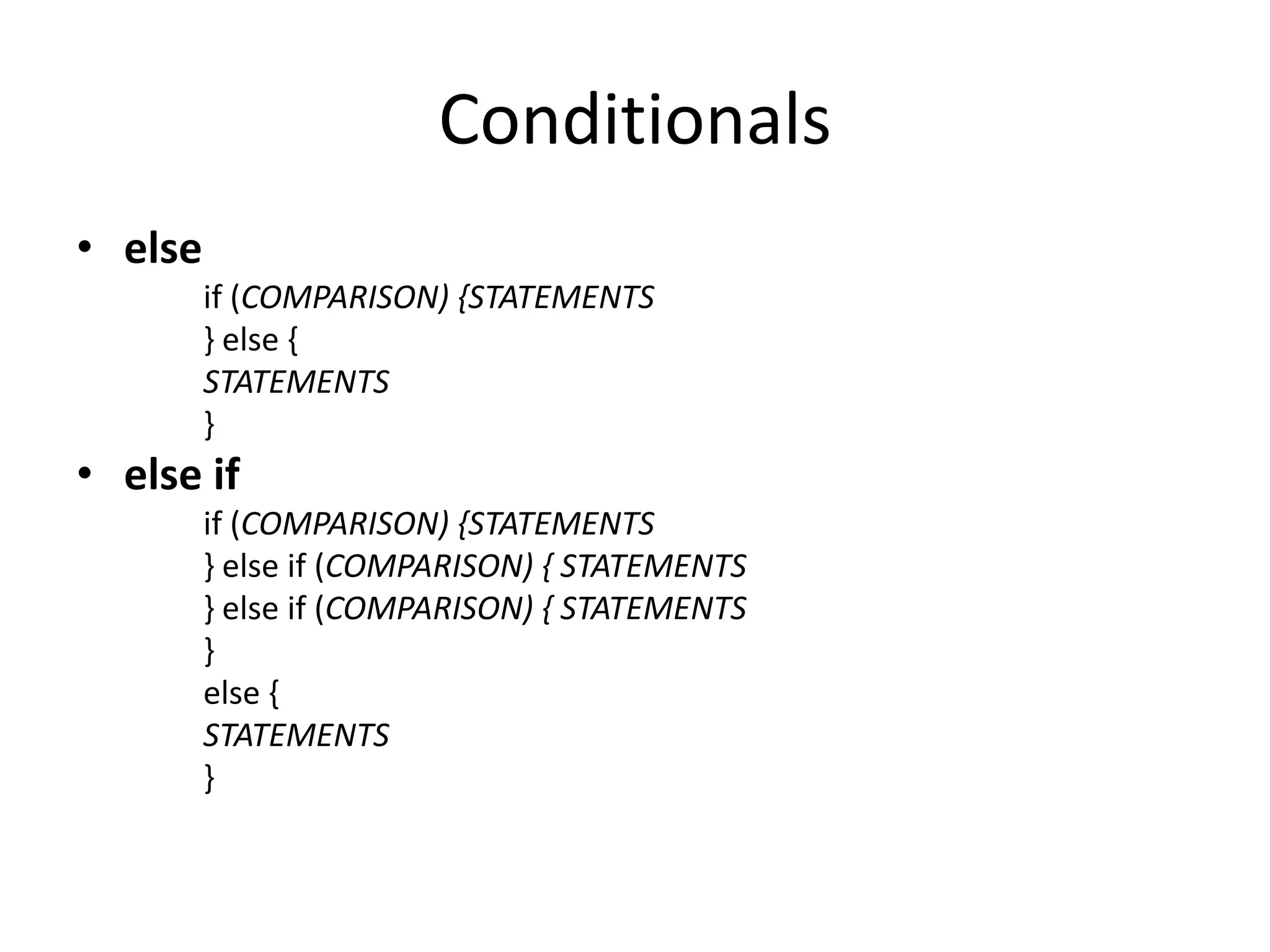
![Conditionals
• Example
public static void test(int x){
if (x > 5){
System.out.println(x + " is > 5");}
else if (x == 5){
System.out.println(x + " equals 5");}
else {
System.out.println(x +”is < 5"); -
}
public static void main(String[] arguments){
test(6);
test(5);
test(4);
}](https://image.slidesharecdn.com/javaintroduction-110515011820-phpapp01/75/Java-introduction-24-2048.jpg)
![Loops
static void main (String[] arguments) {
System.out.println(“This is line 1”);
System.out.println(“This is line 2”);
System.out.println(“This is line 3”);
}
• What if you want to do it for 200 lines?
• Loop operators allow to loop through a block
of code.
• There are several loop operators in Java.](https://image.slidesharecdn.com/javaintroduction-110515011820-phpapp01/75/Java-introduction-25-2048.jpg)
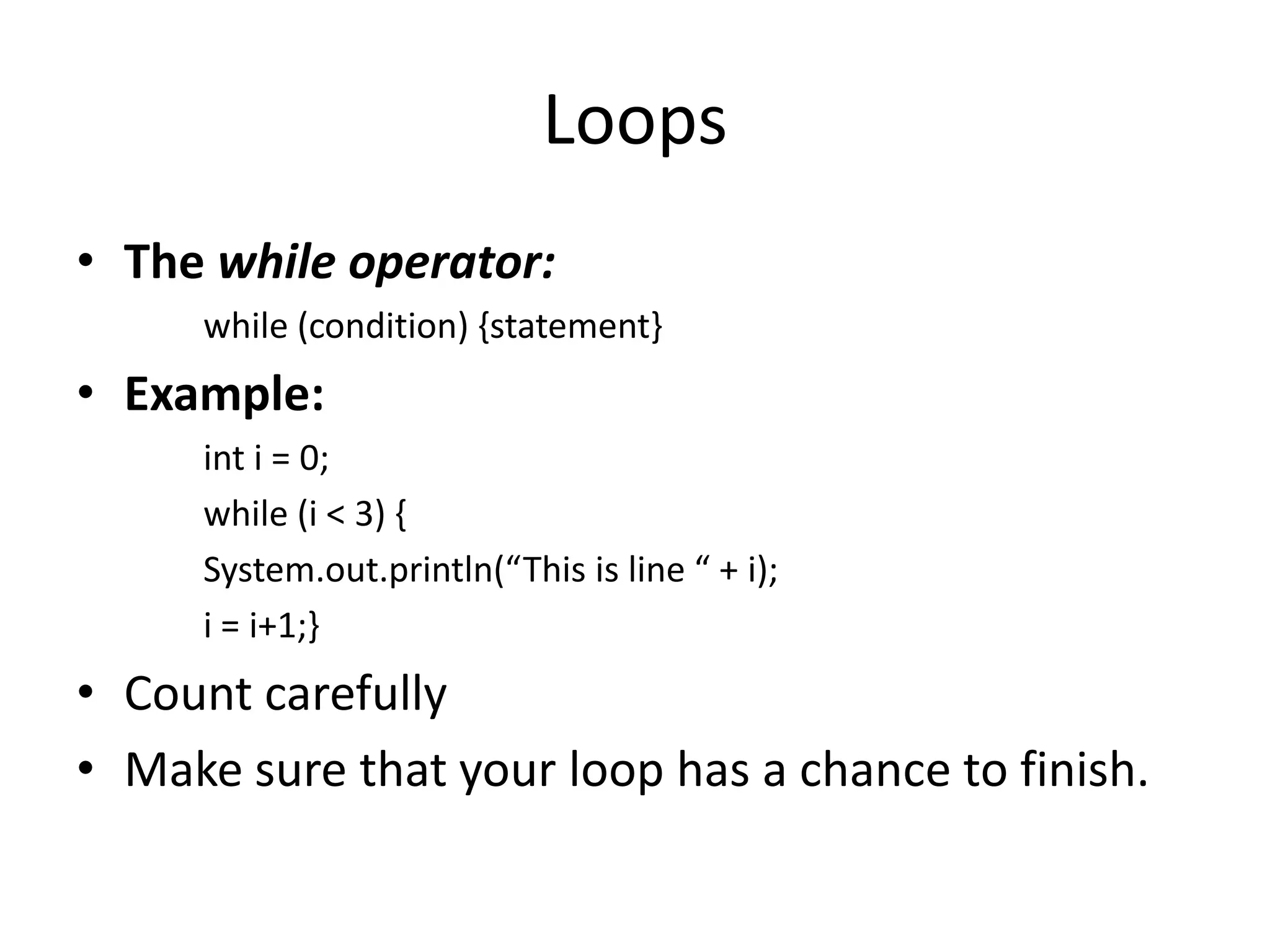
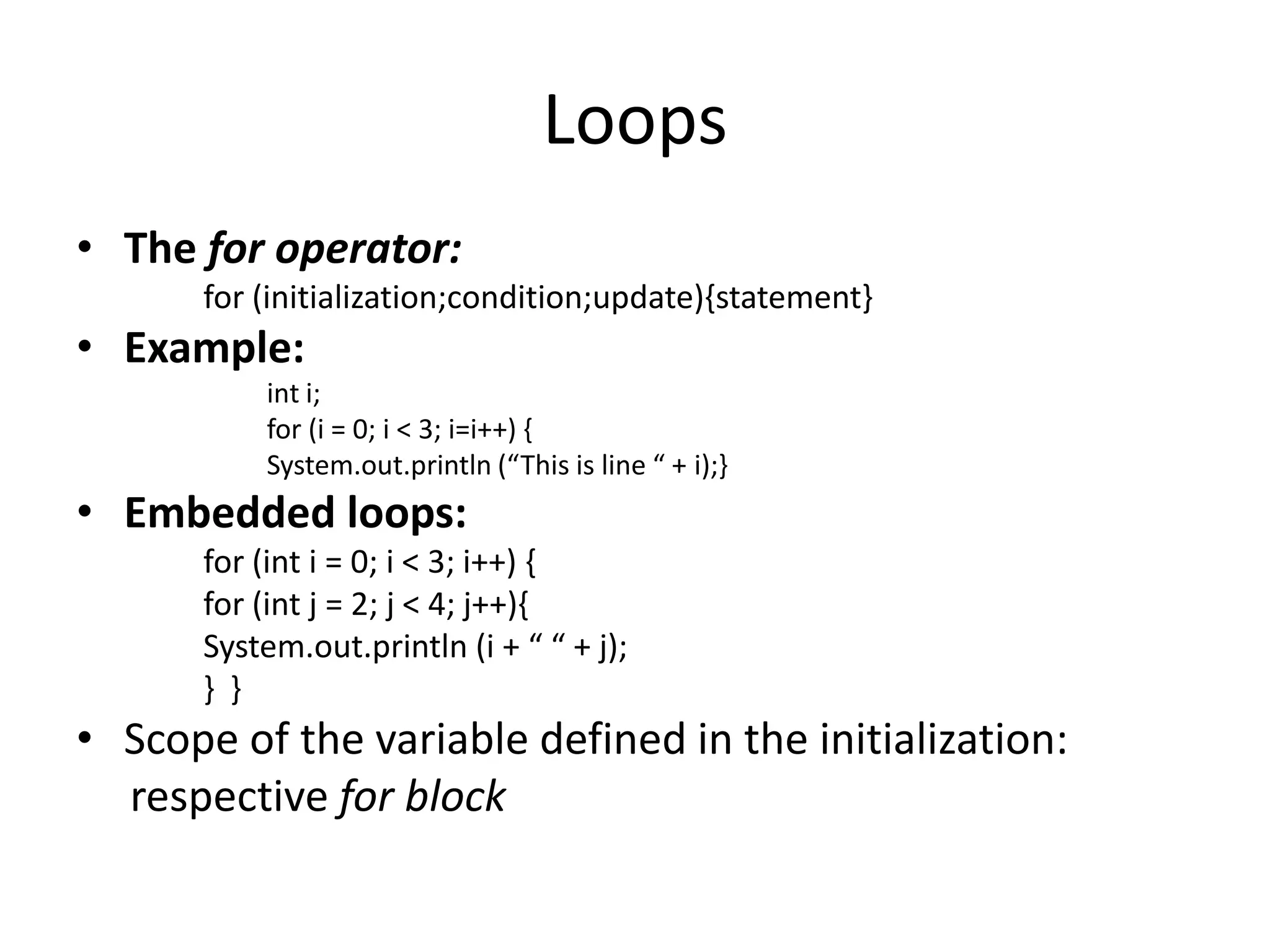
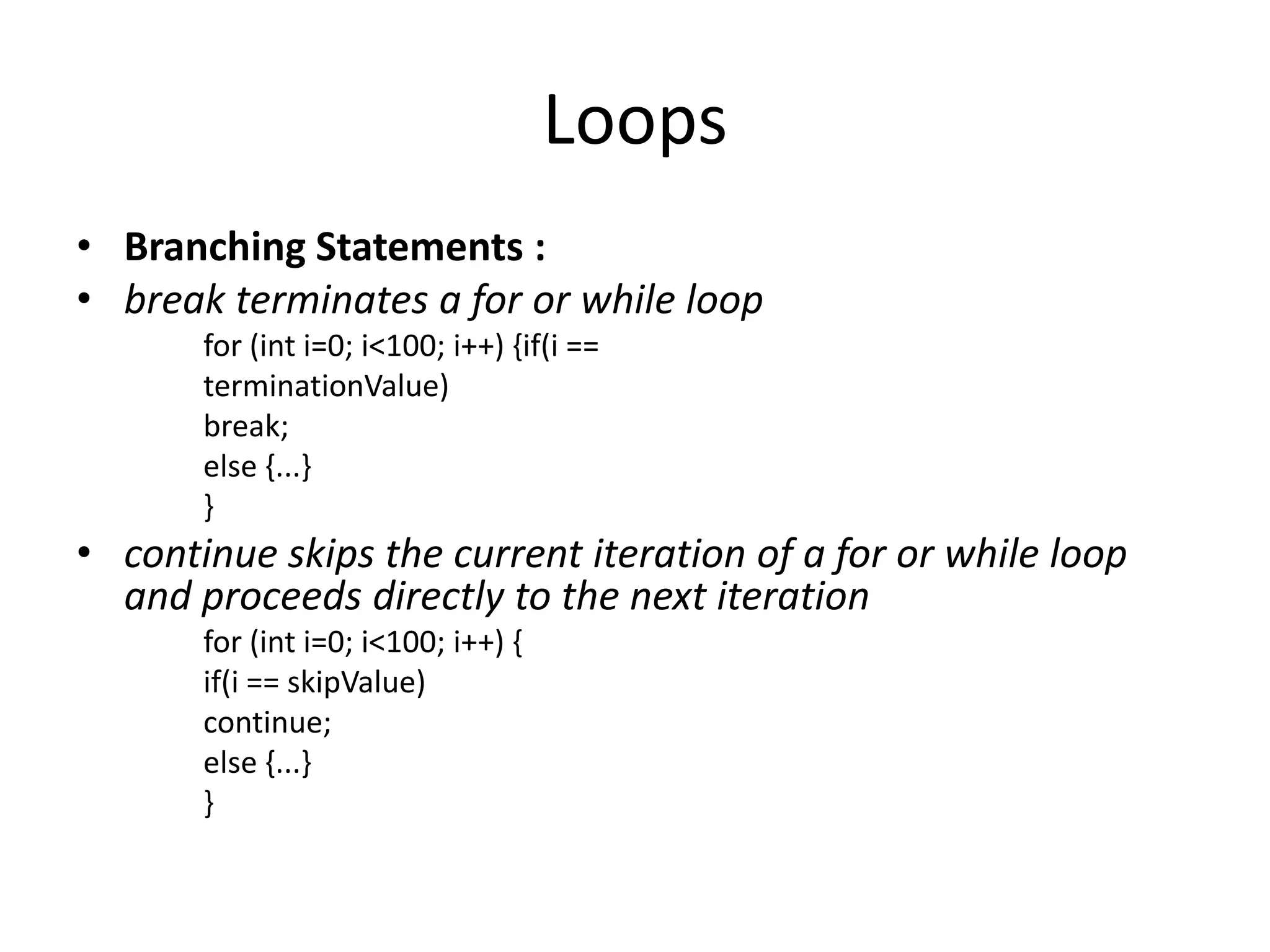
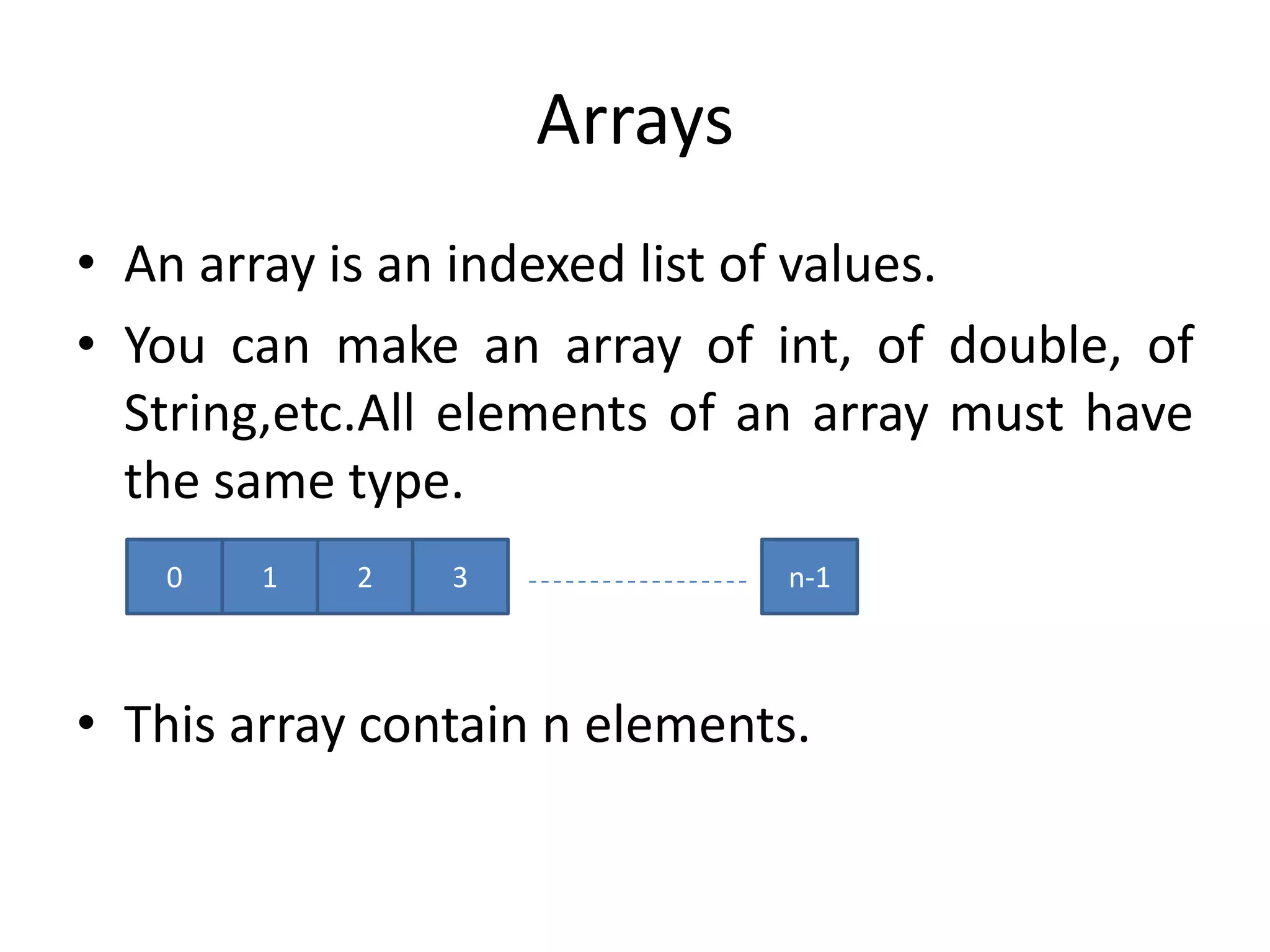
![Arrays
• An array is noted using [] and is declared in the
usual way:
int values[]; // empty array
int[] values; // equivalent declaration
• To create an array of a given size, use the
operator new :
int values[] = new int[5];
• or you may use a variable to specify the size:
int size = 12;
int values[] = new int[size];](https://image.slidesharecdn.com/javaintroduction-110515011820-phpapp01/75/Java-introduction-30-2048.jpg)
![Arrays
• Array Initialization:
• Curly braces can be used to initialize an array in
the array declaration statement (and only there).
int values[] = { 12, 24, -23, 47 };
• To access the elements of an array, use the []
operator: values[index]
• Example:
int values[] = { 12, 24, -23, 47 };
values[3] = 18; // write
int x = values[1] + 3; // read](https://image.slidesharecdn.com/javaintroduction-110515011820-phpapp01/75/Java-introduction-31-2048.jpg)
![Arrays
• Each array has a length variable built-in that contains the length of the array.
int values[] = new int[12];
int size = values.length; // 12
• Looping through an array
• Example :
int values[] = new int[5];
for (int i=0; i<values.length; i++) {
values[i] = i;
int y = values[i] *values[i];
System.out.println(y);
}
• Another one:
double values[] = new double[25];
int j=0;
while (j<values.length) {...
j++;
}](https://image.slidesharecdn.com/javaintroduction-110515011820-phpapp01/75/Java-introduction-32-2048.jpg)
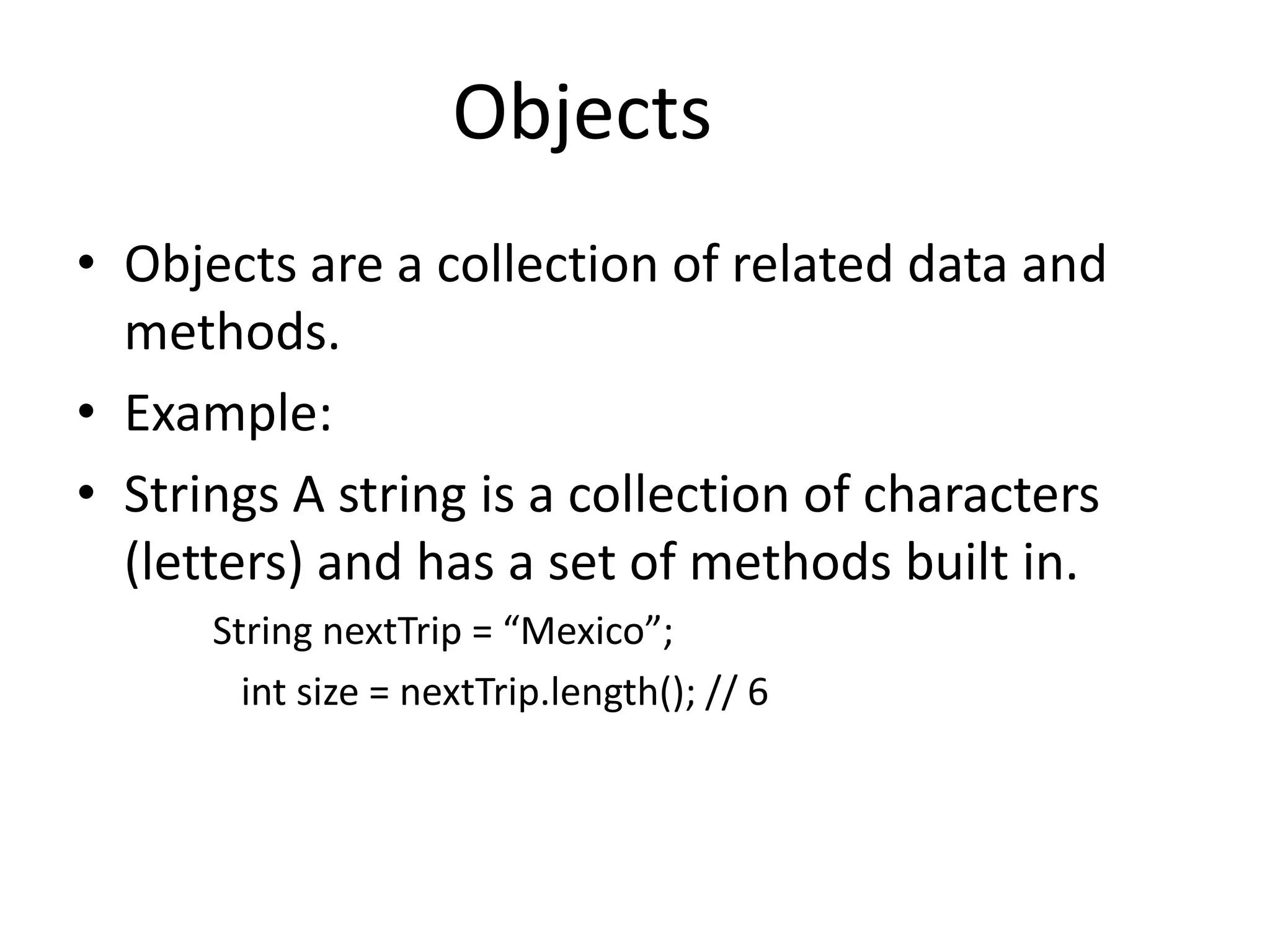
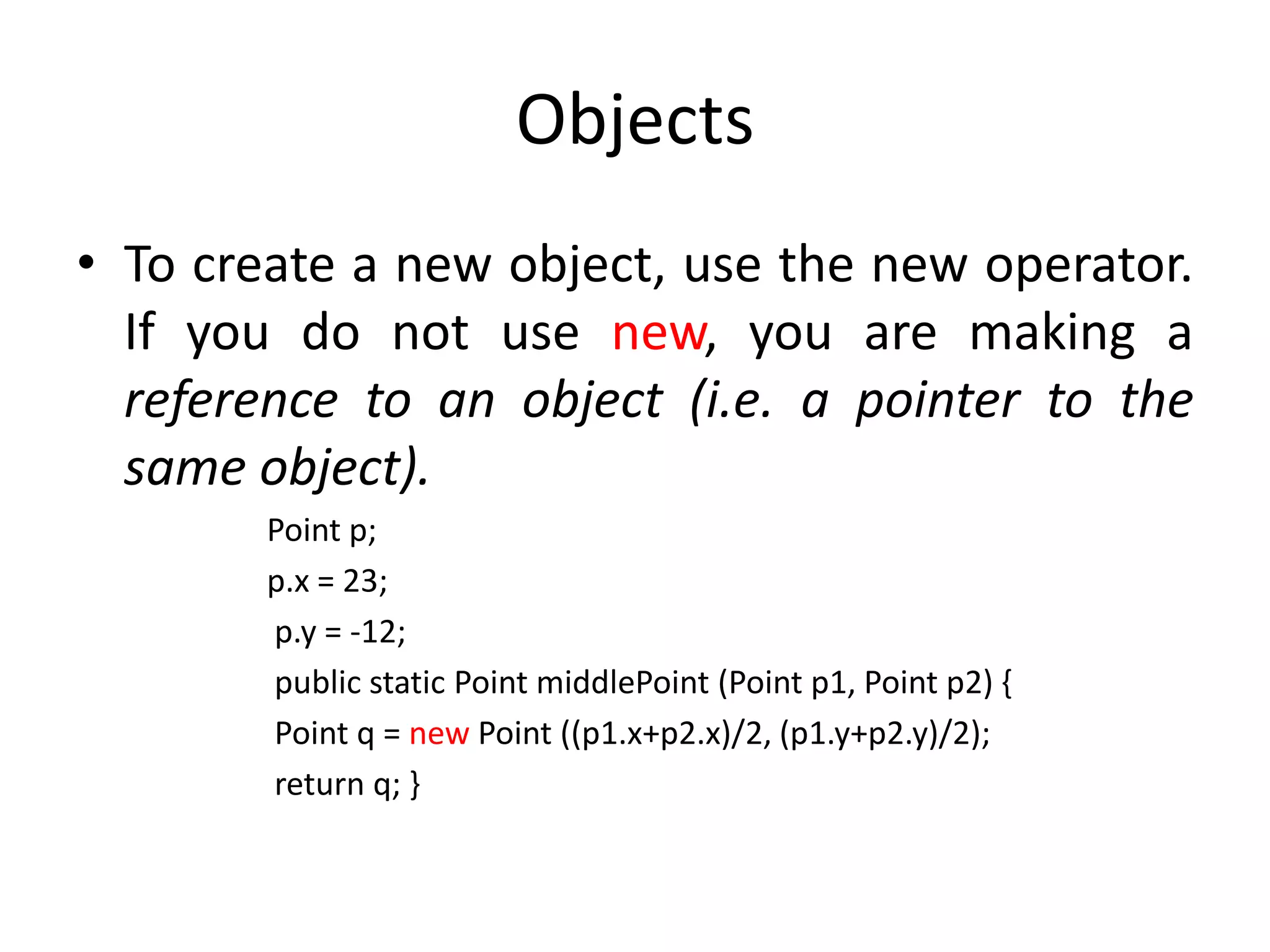
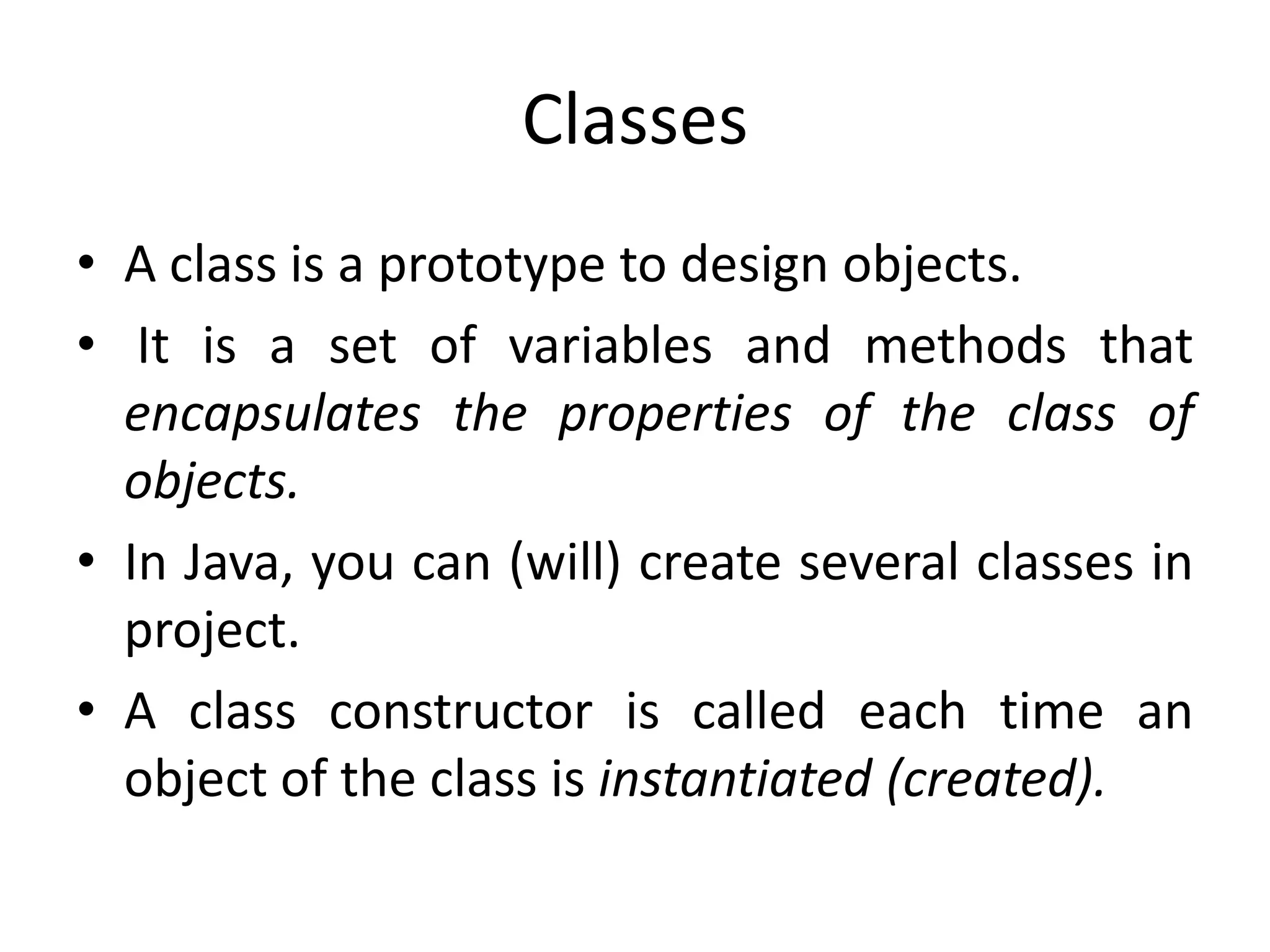
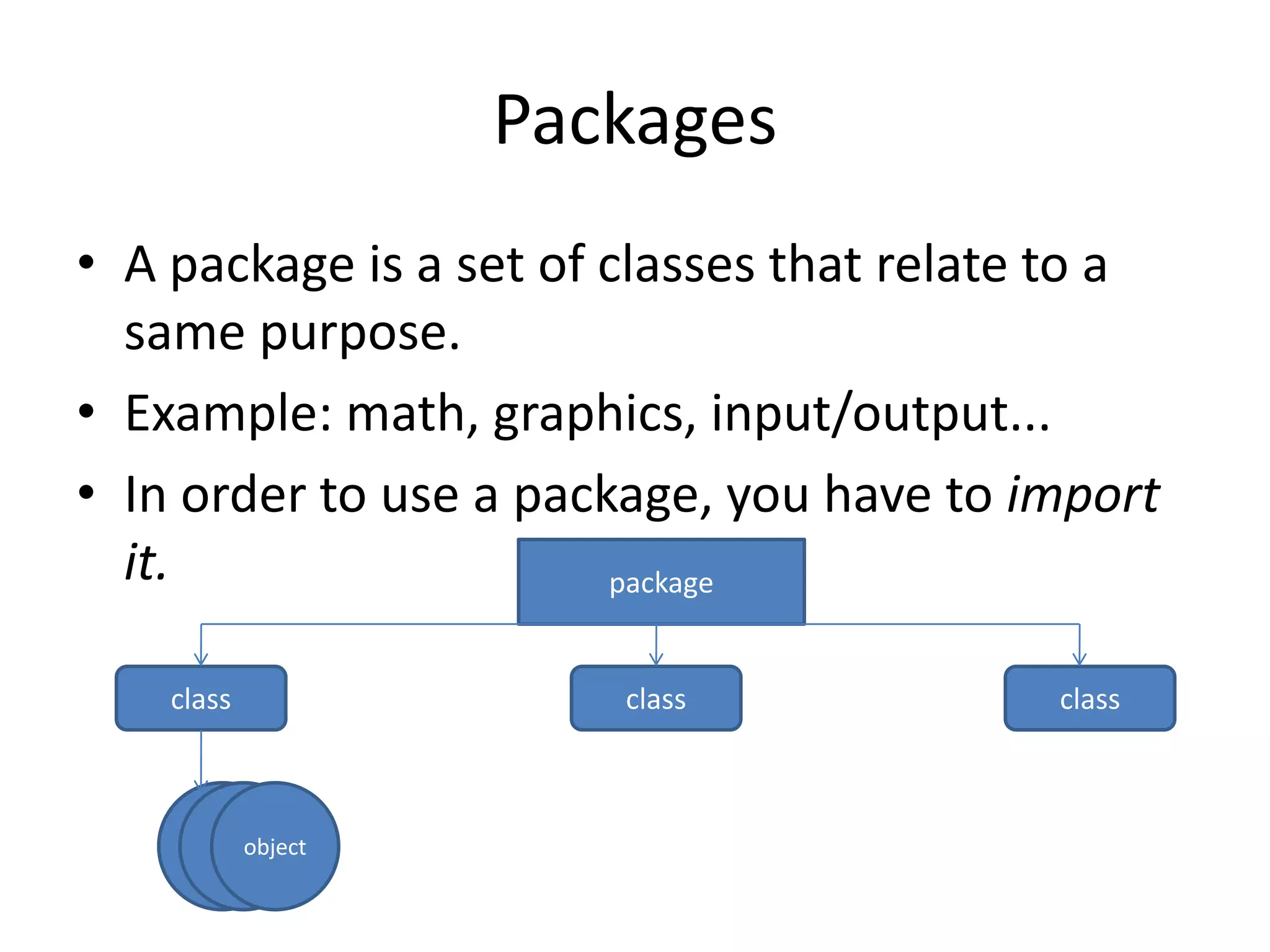
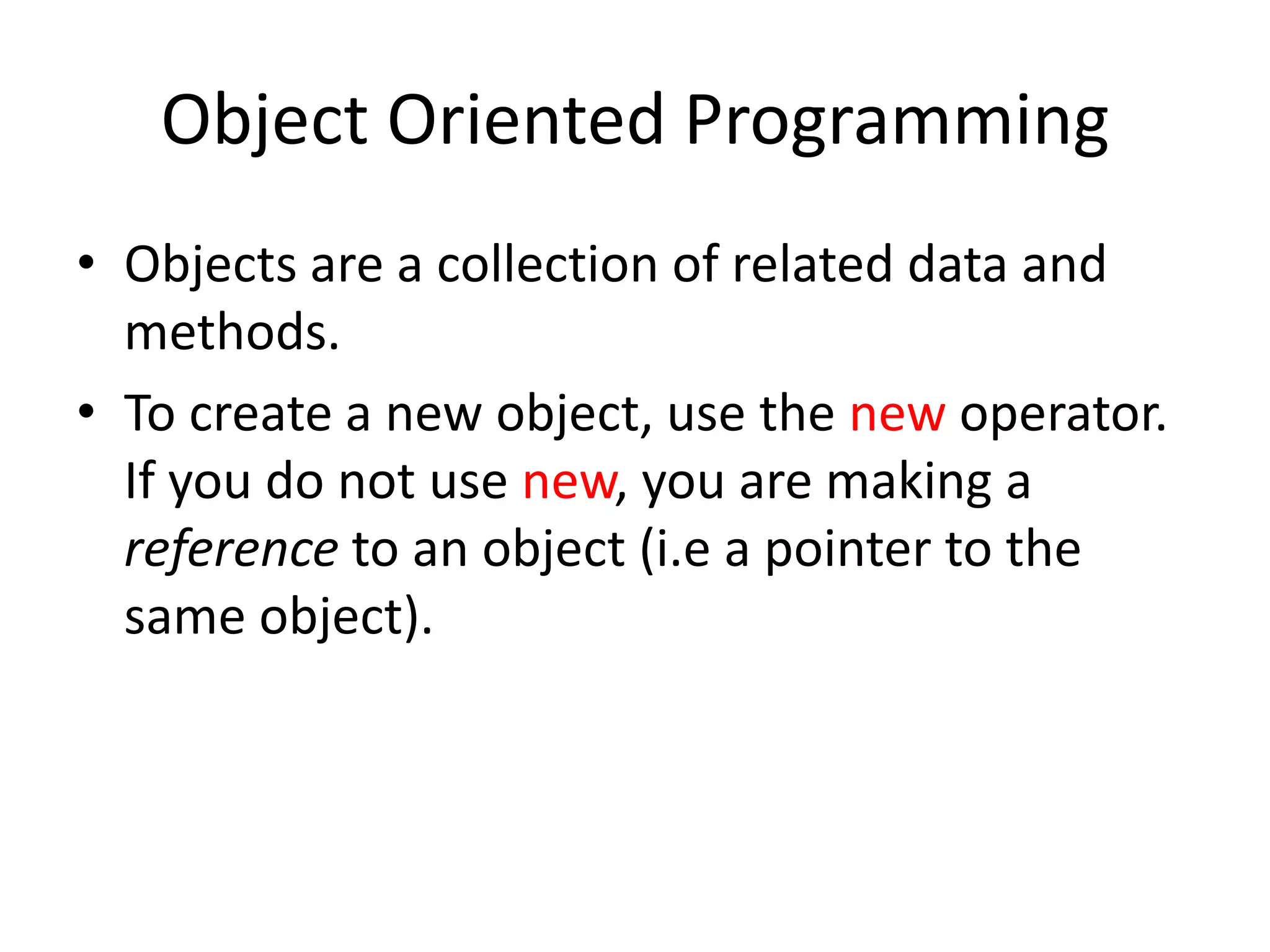
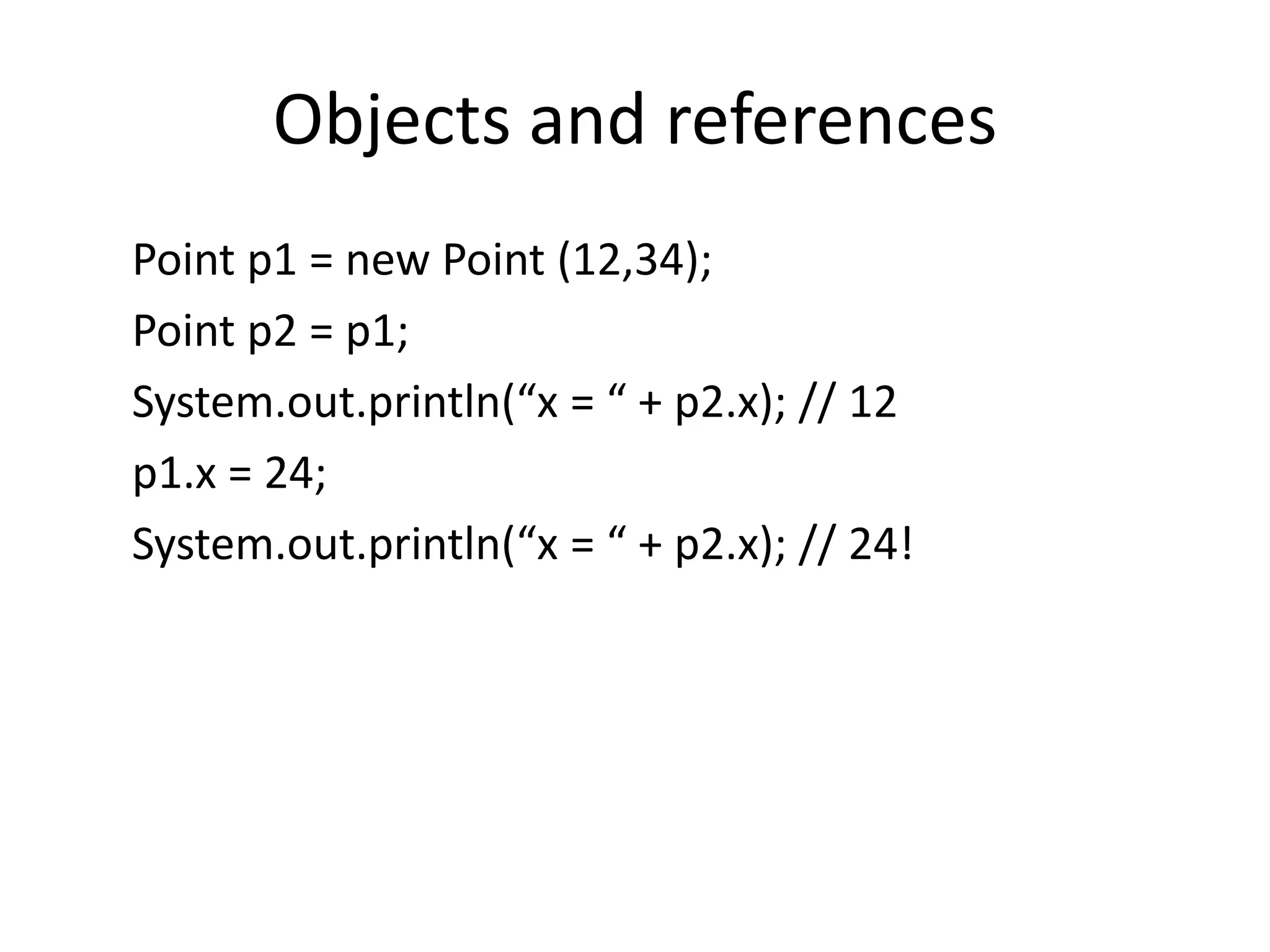
![The null object
• null simply represents no object. It is
convenient
• as a return value to mean that a method failed
for example. It may also be used to “remove”
an element from an array.
String values[] = { “ragab”, “ahmed”, “zidan” };
values[1] = null;](https://image.slidesharecdn.com/javaintroduction-110515011820-phpapp01/75/Java-introduction-39-2048.jpg)
![Object methods v.s. class methods
class Bicycle {
static int gear, speed;
public static void speedUp (Bicycle b) {
b.speed += 10;}
public static void main (String[] arguments) {
Bicycle bike1 = new Bicycle();
speedUp (bike1); }}
• static means that the variable is going to be same
for all objects of the class.
• Class methods are declared static.
• static = the same for all objects
• nonstatic = different for each object](https://image.slidesharecdn.com/javaintroduction-110515011820-phpapp01/75/Java-introduction-40-2048.jpg)
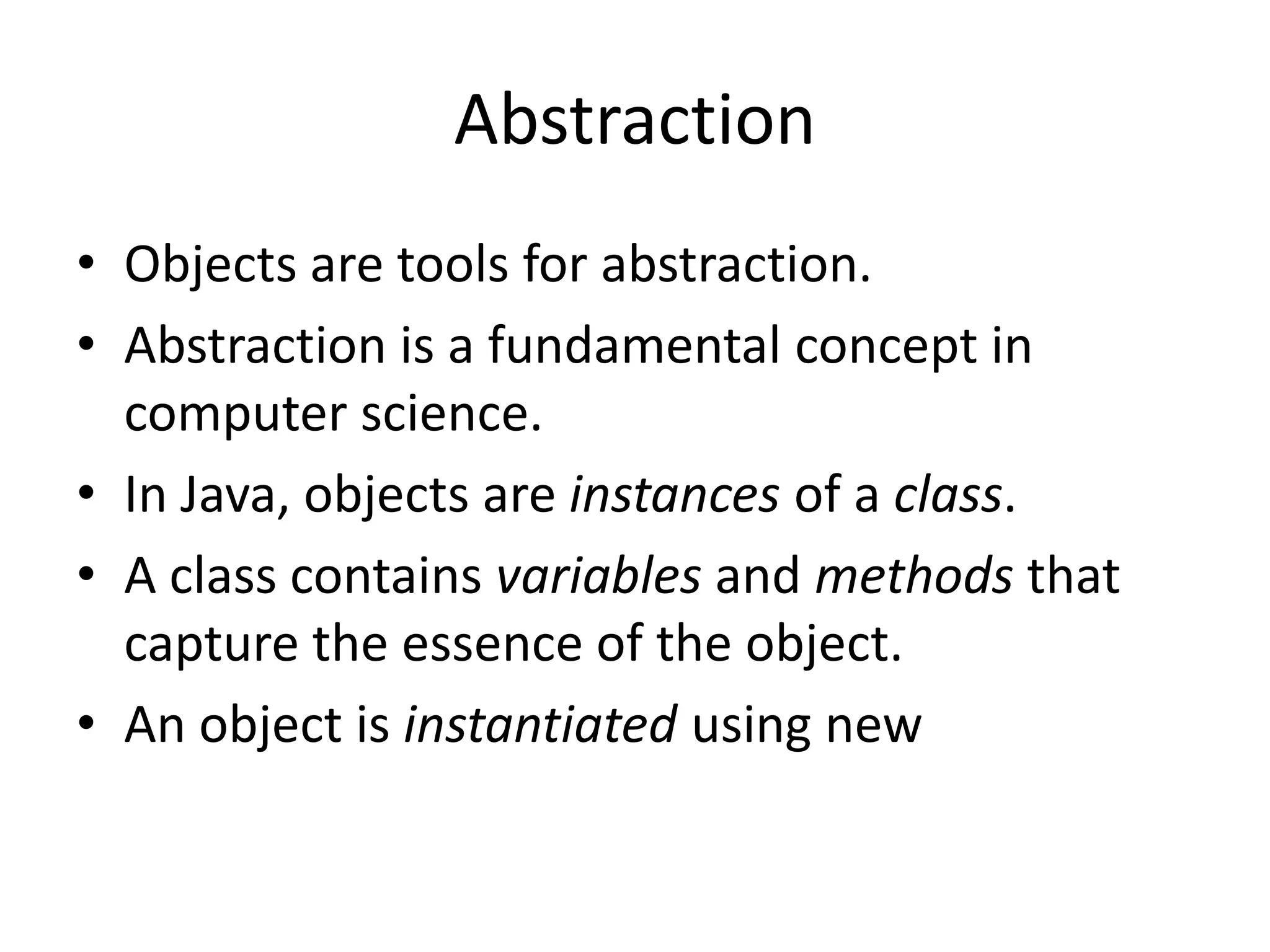
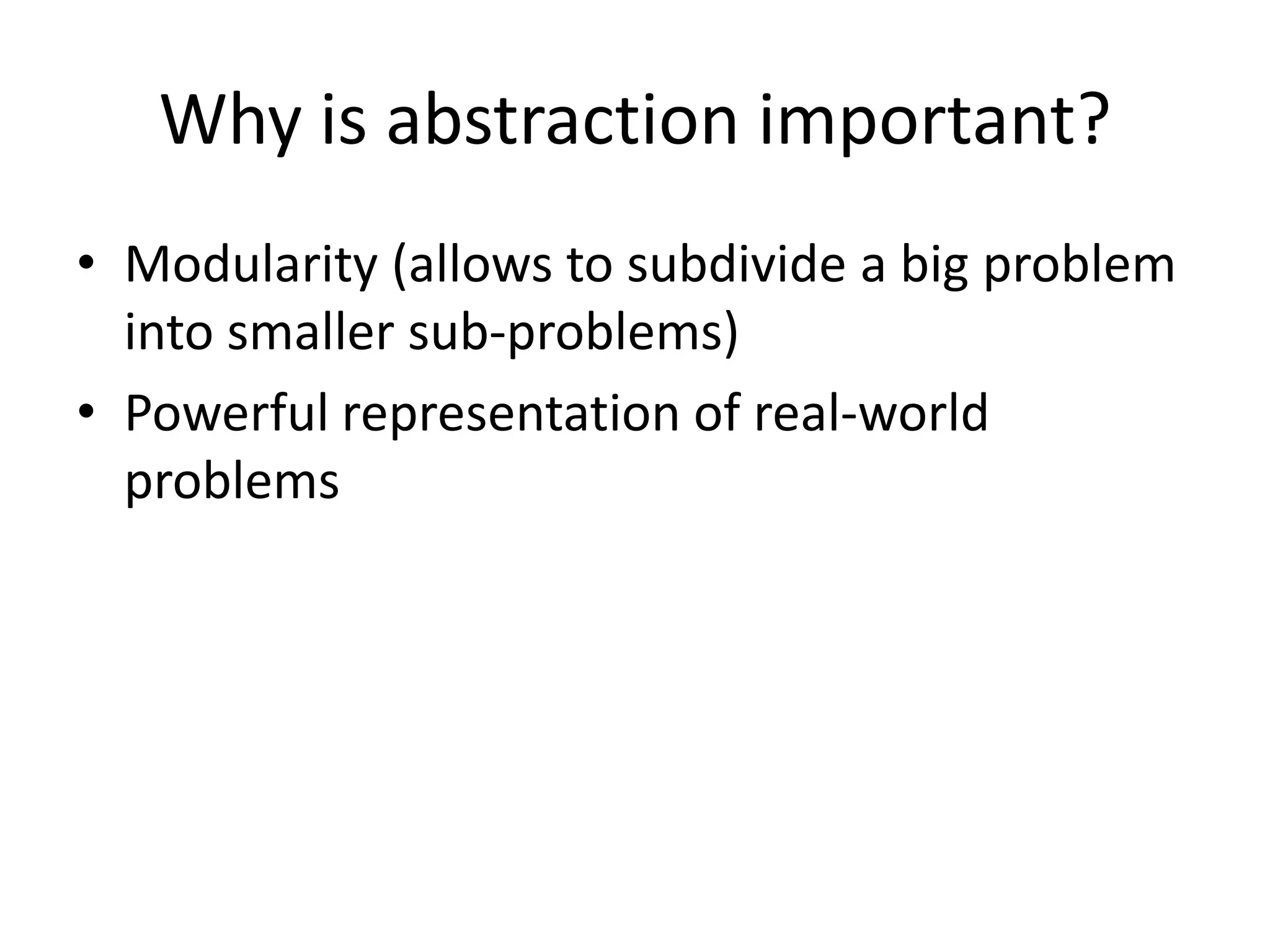
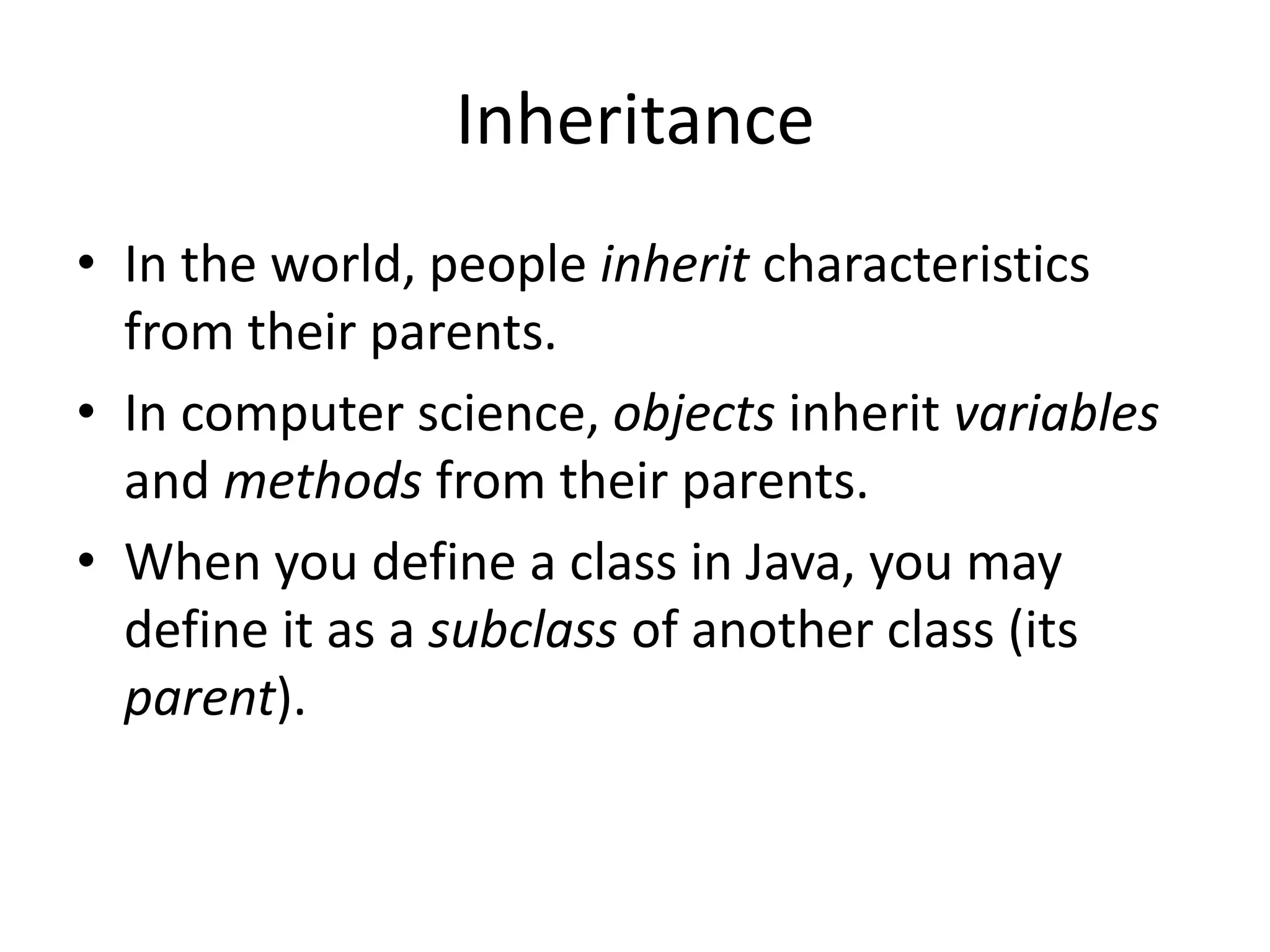
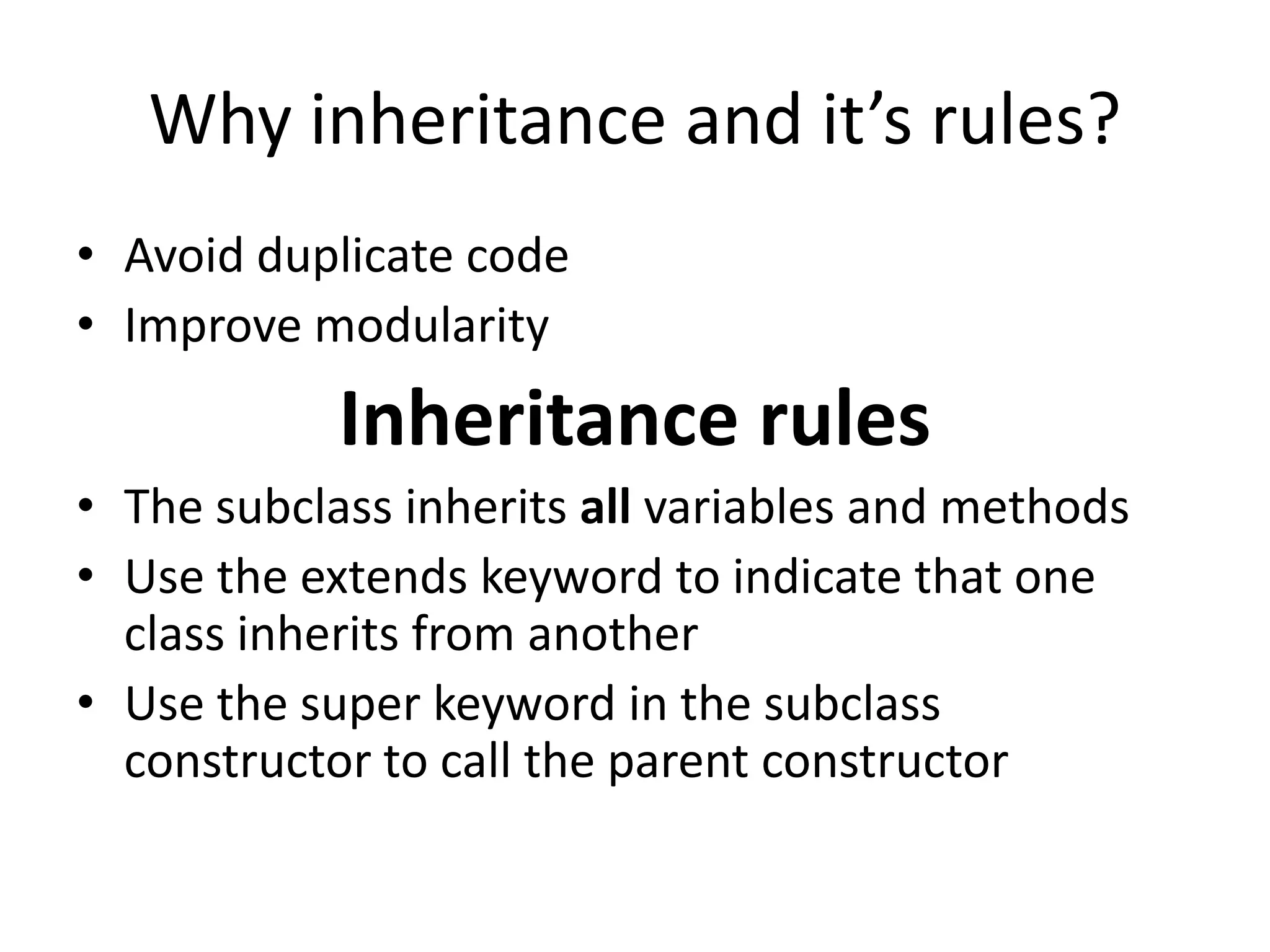
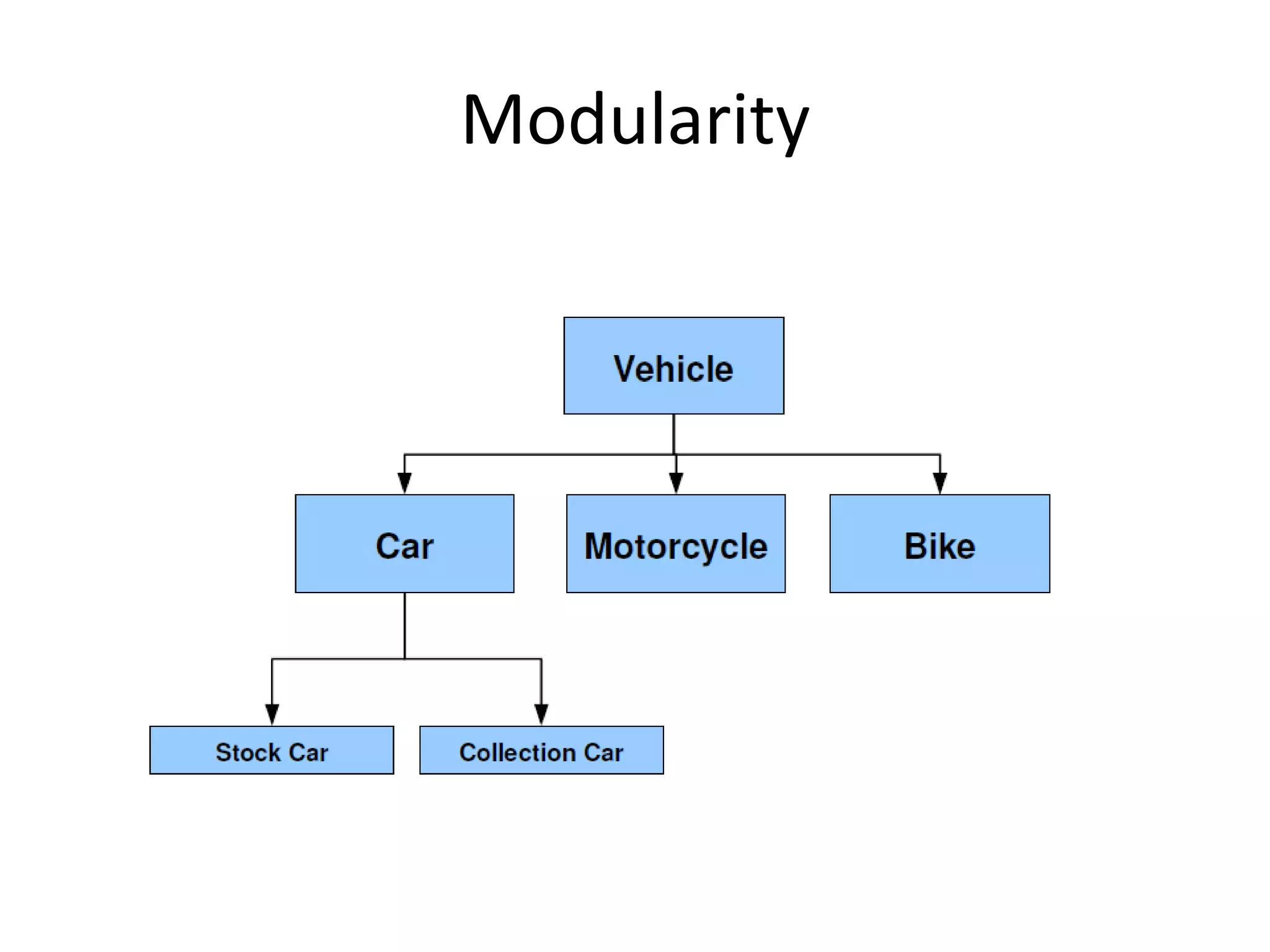
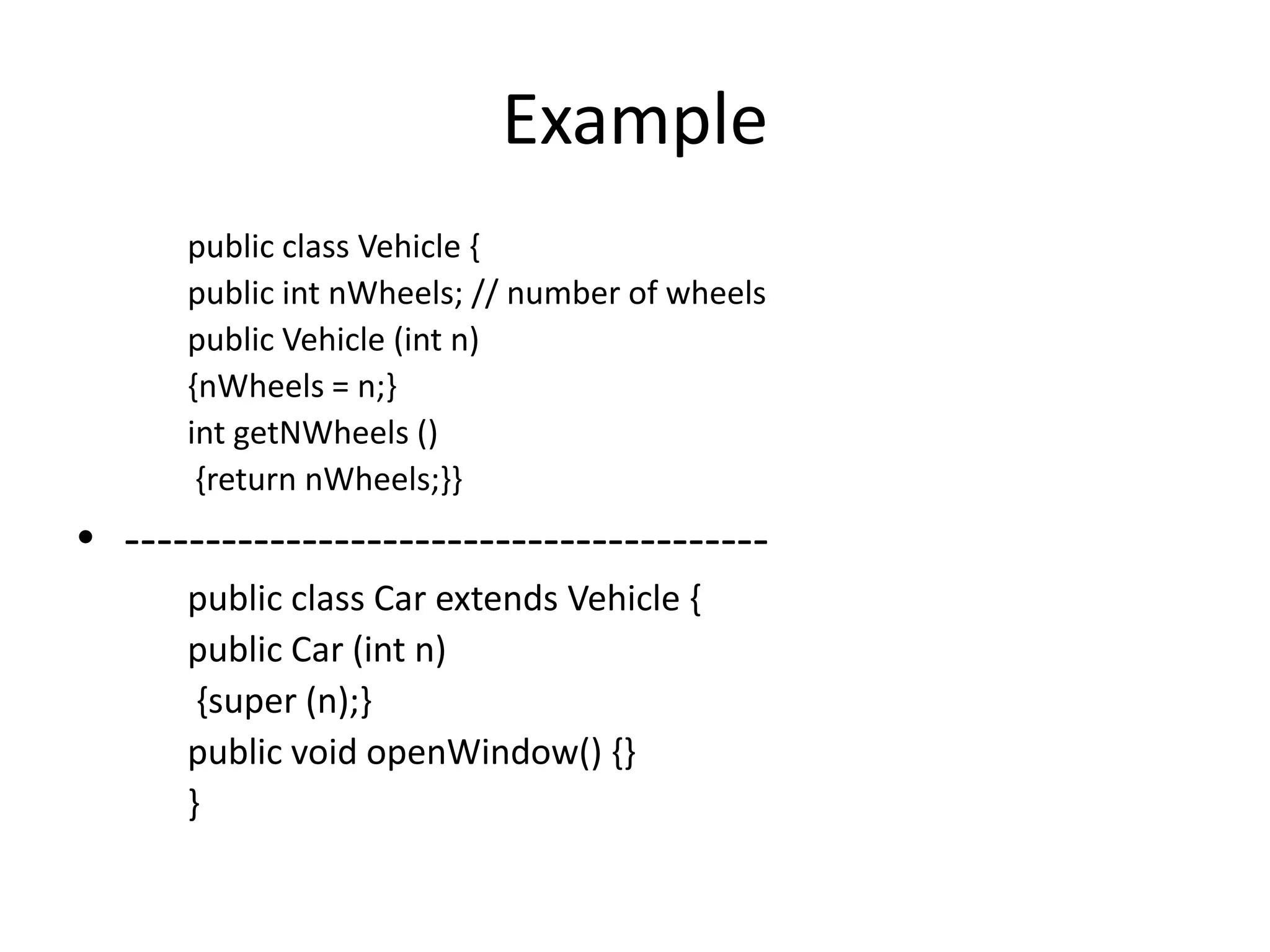
![Example
public class Bicycle extends Vehicle {
public Bicycle (int n)
{super (n);}
public void freeStyle() {}
}
• -------------------------------------
public class World {
public static void main (String[] args) {
Bicycle bike = new Bike (2);
Car car = new Car (4);
System.out.println (“Car has “ +car.getNWheels() + “ wheels”);
System.out.println (“Bike has “ +bike.getNWheels() + “ wheels”);--](https://image.slidesharecdn.com/javaintroduction-110515011820-phpapp01/75/Java-introduction-47-2048.jpg)
